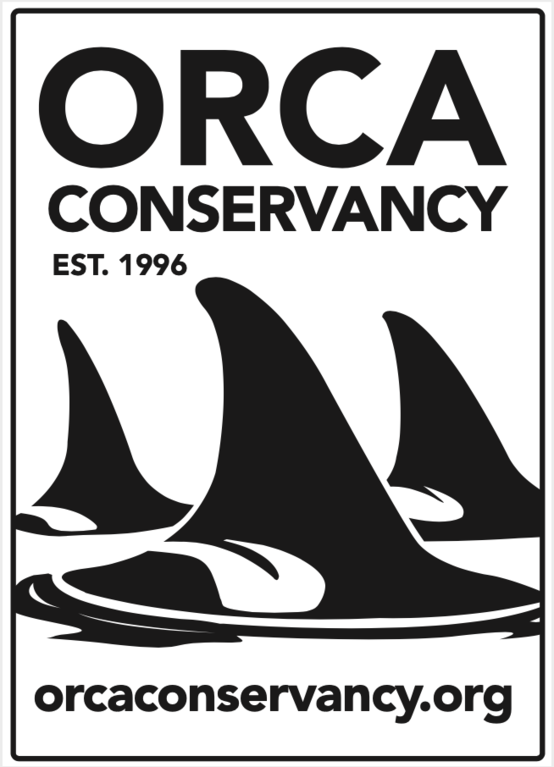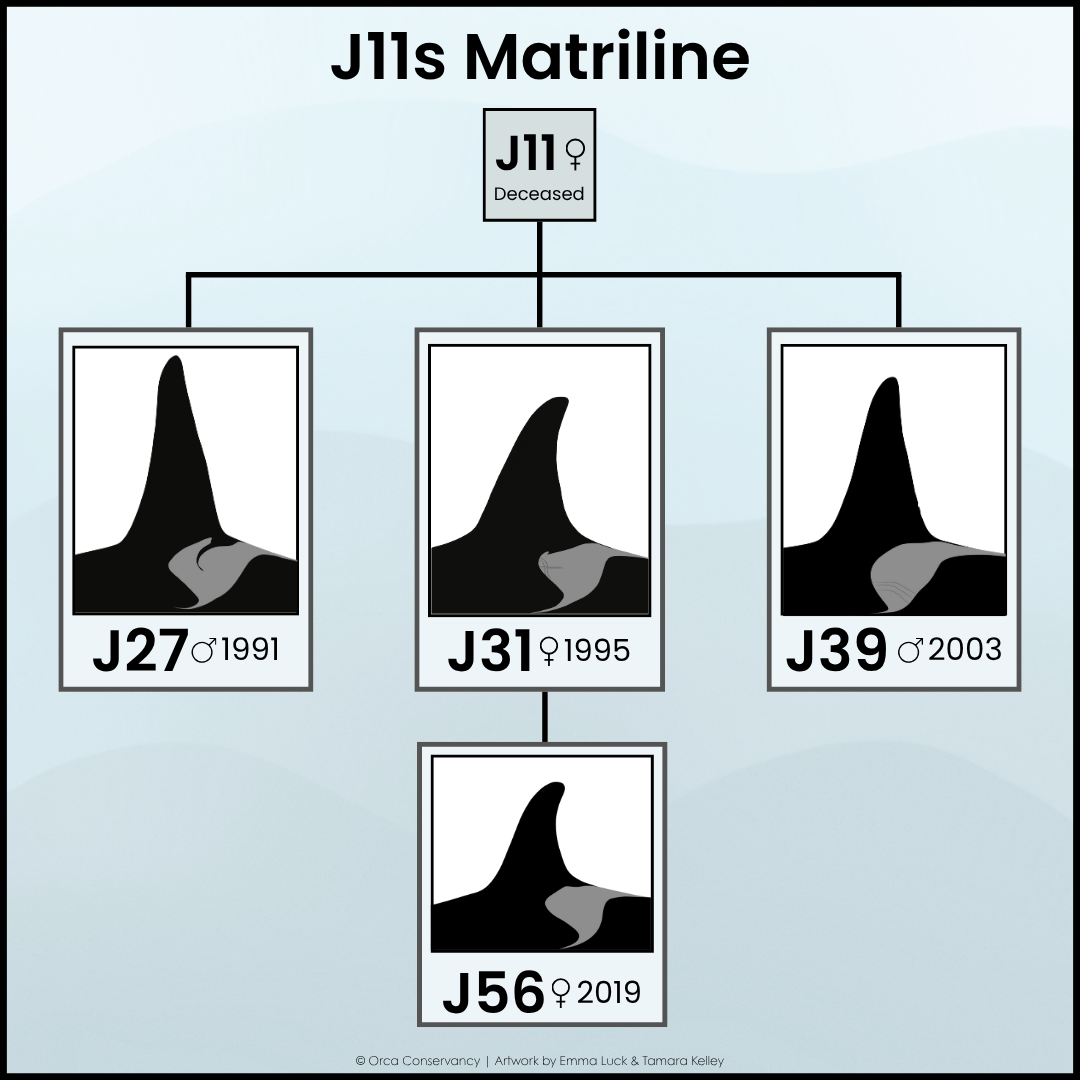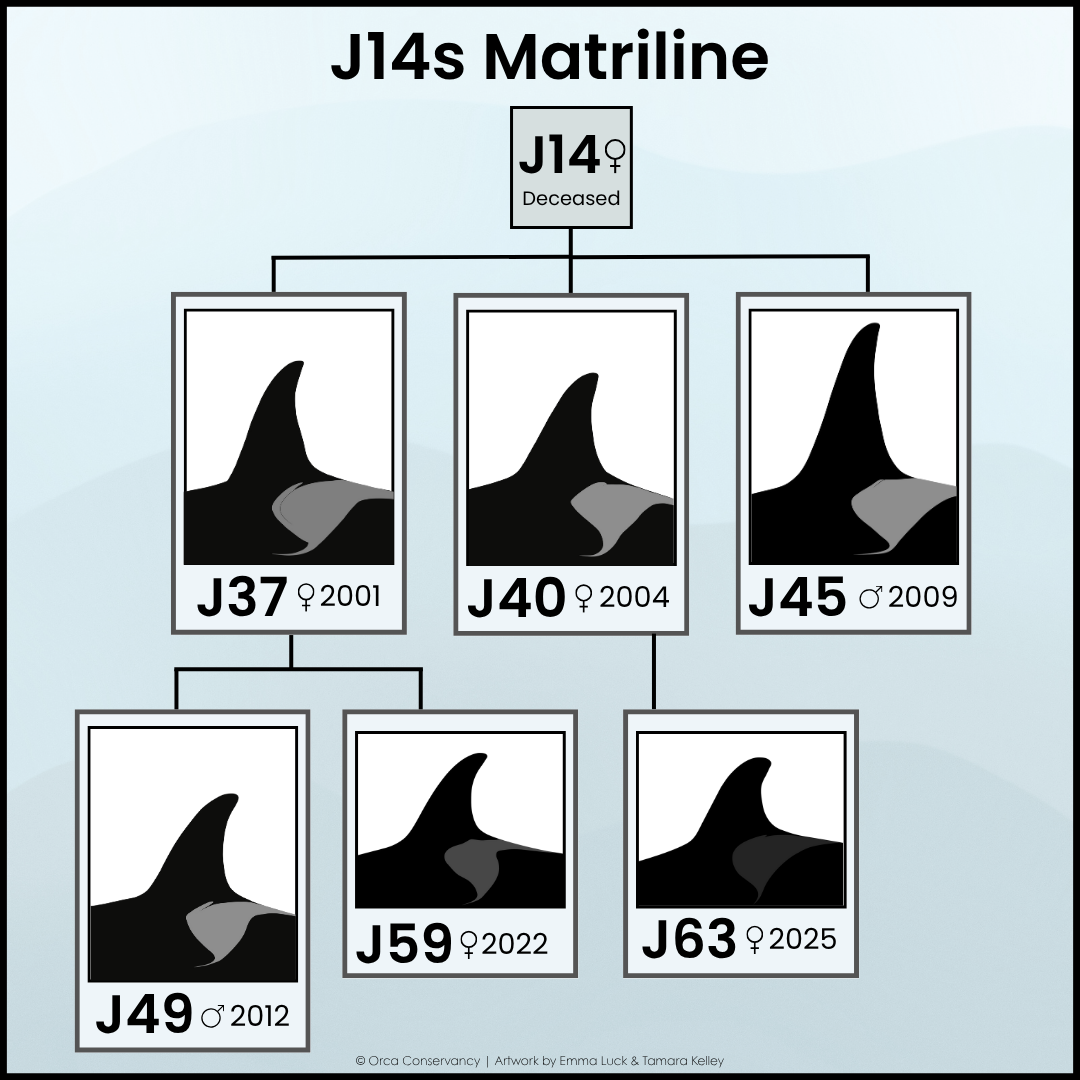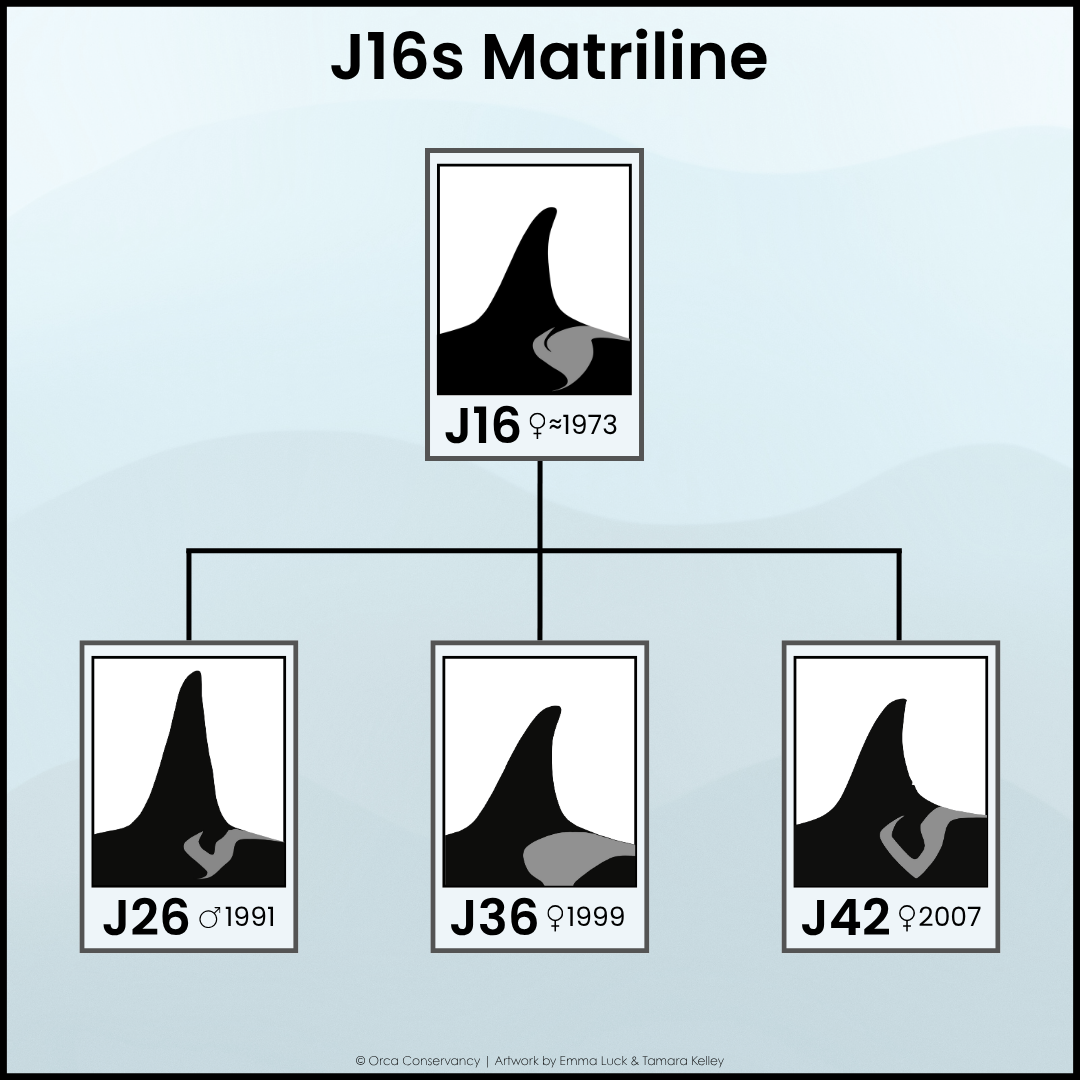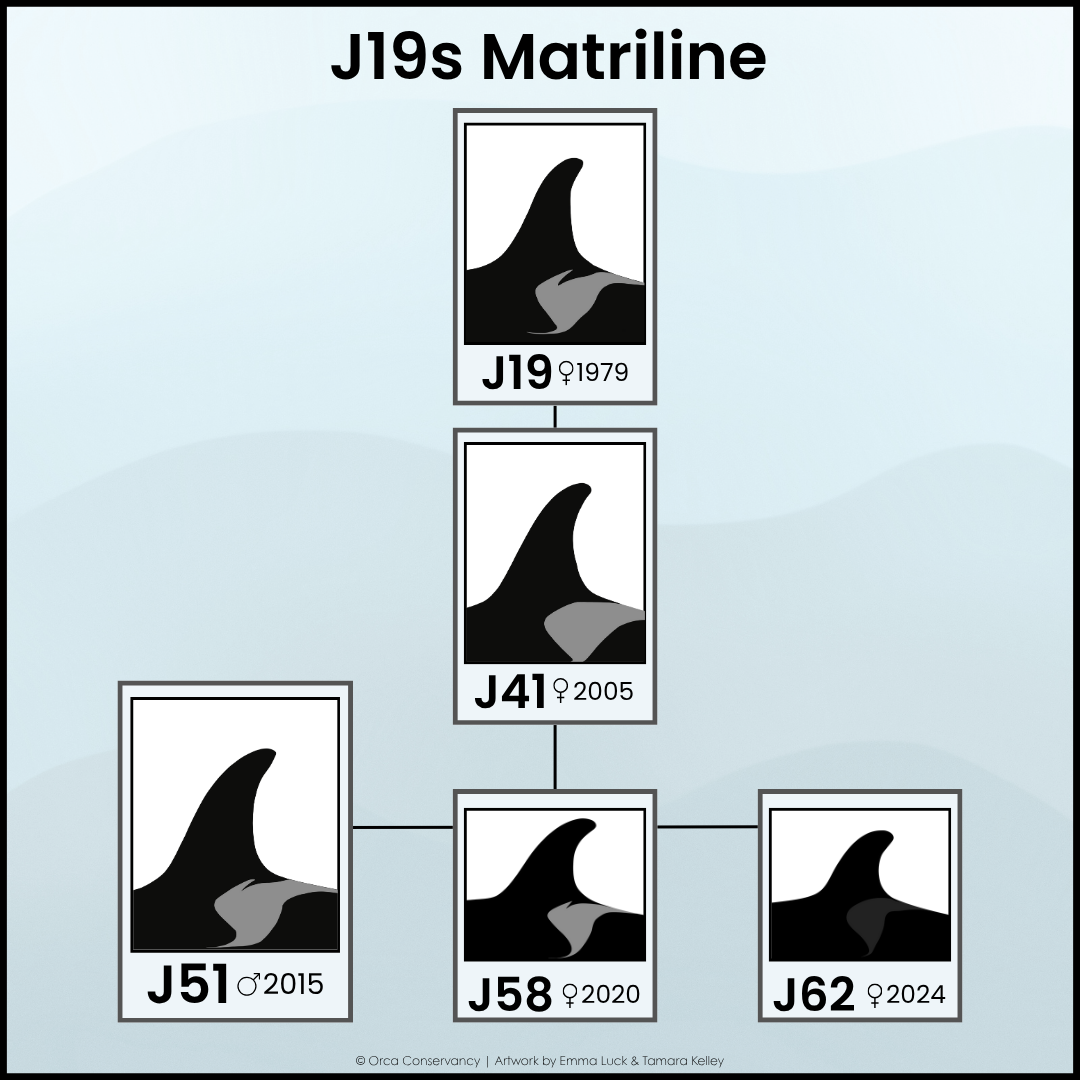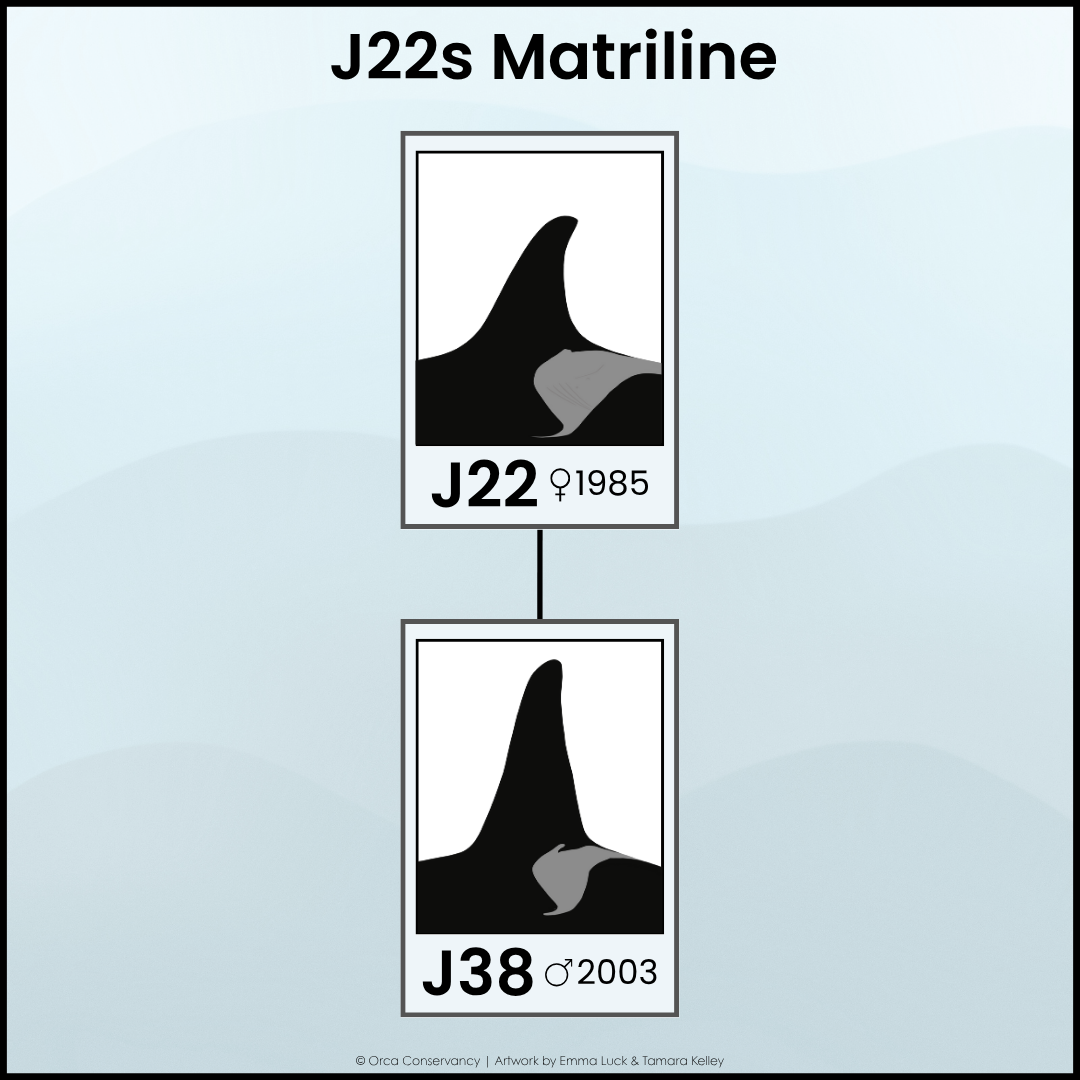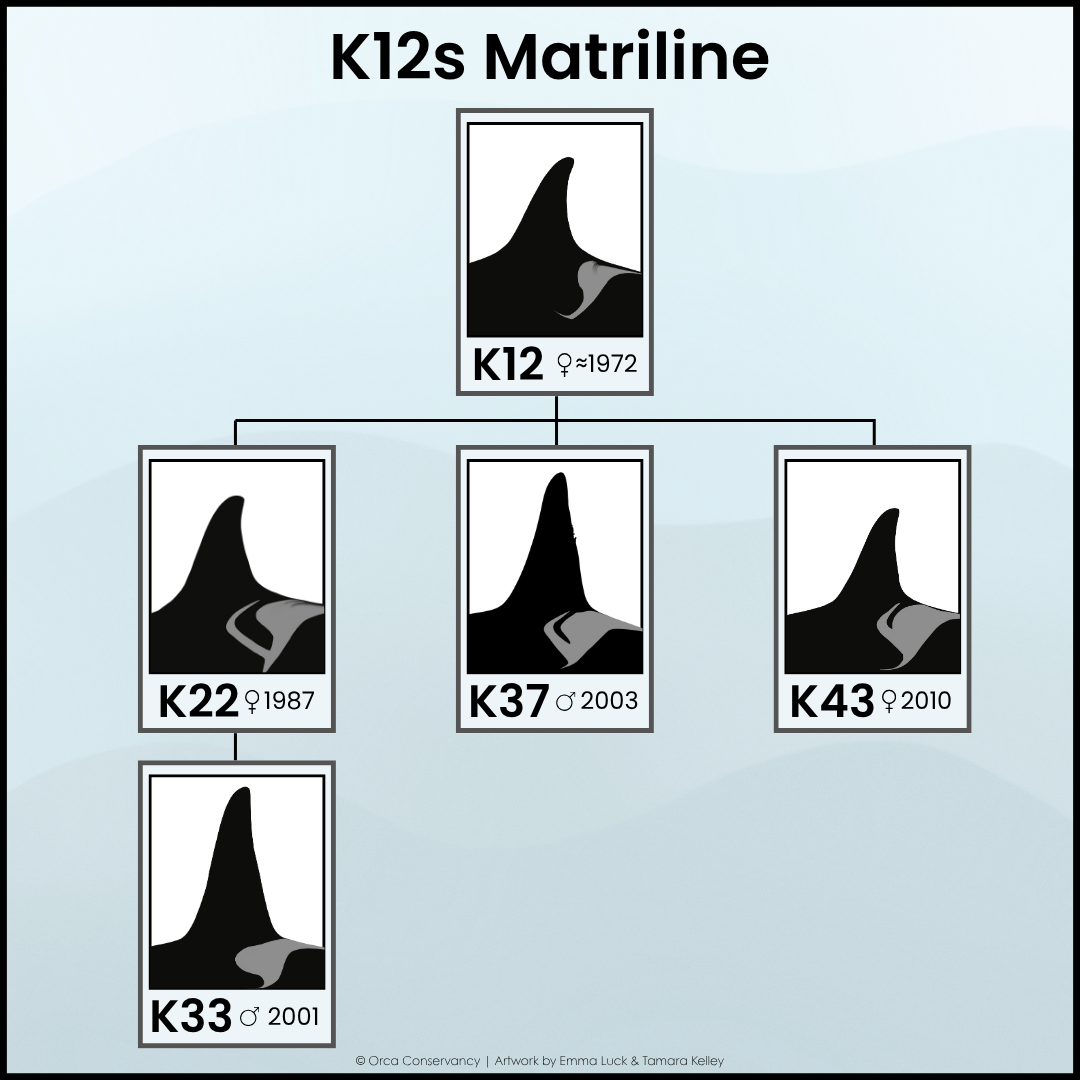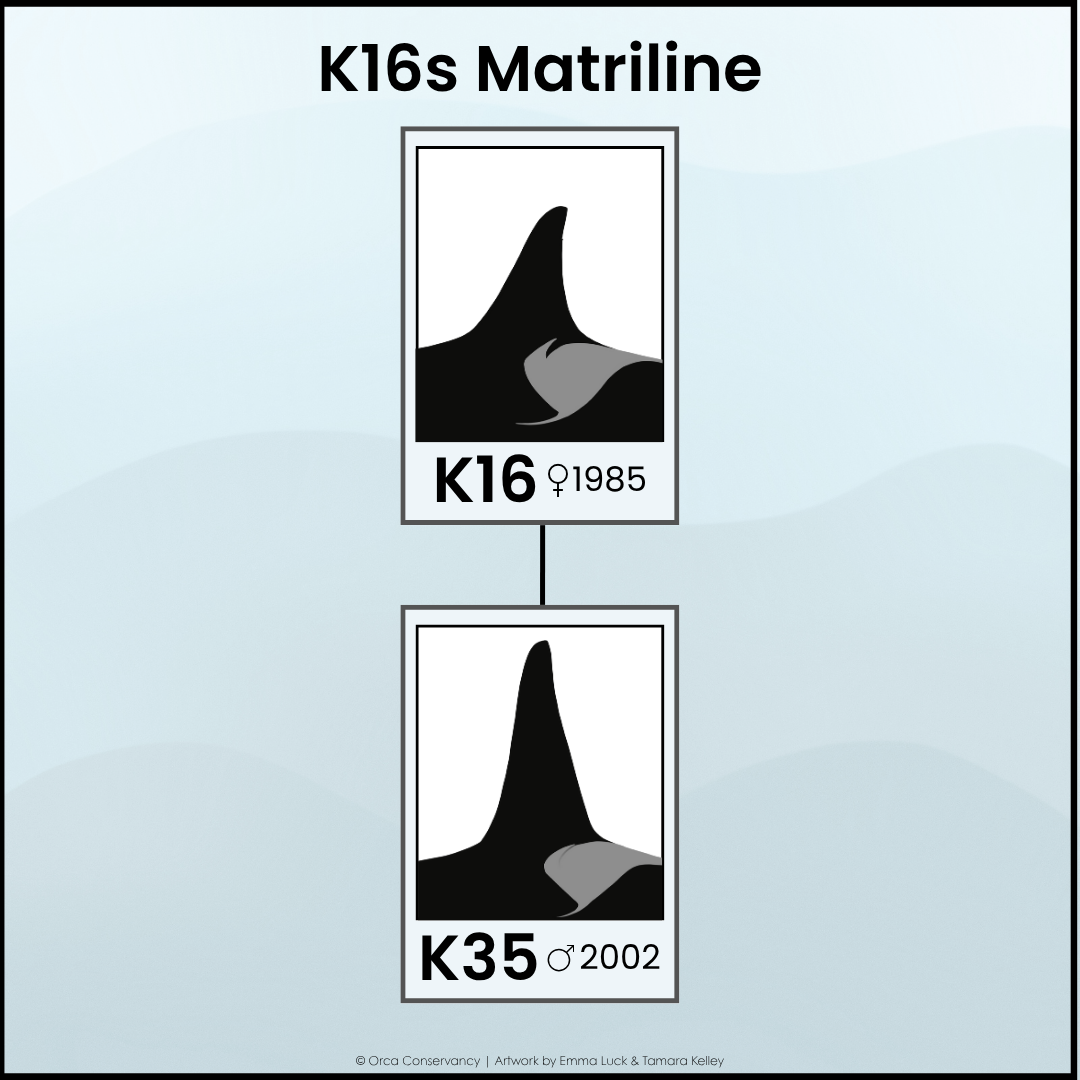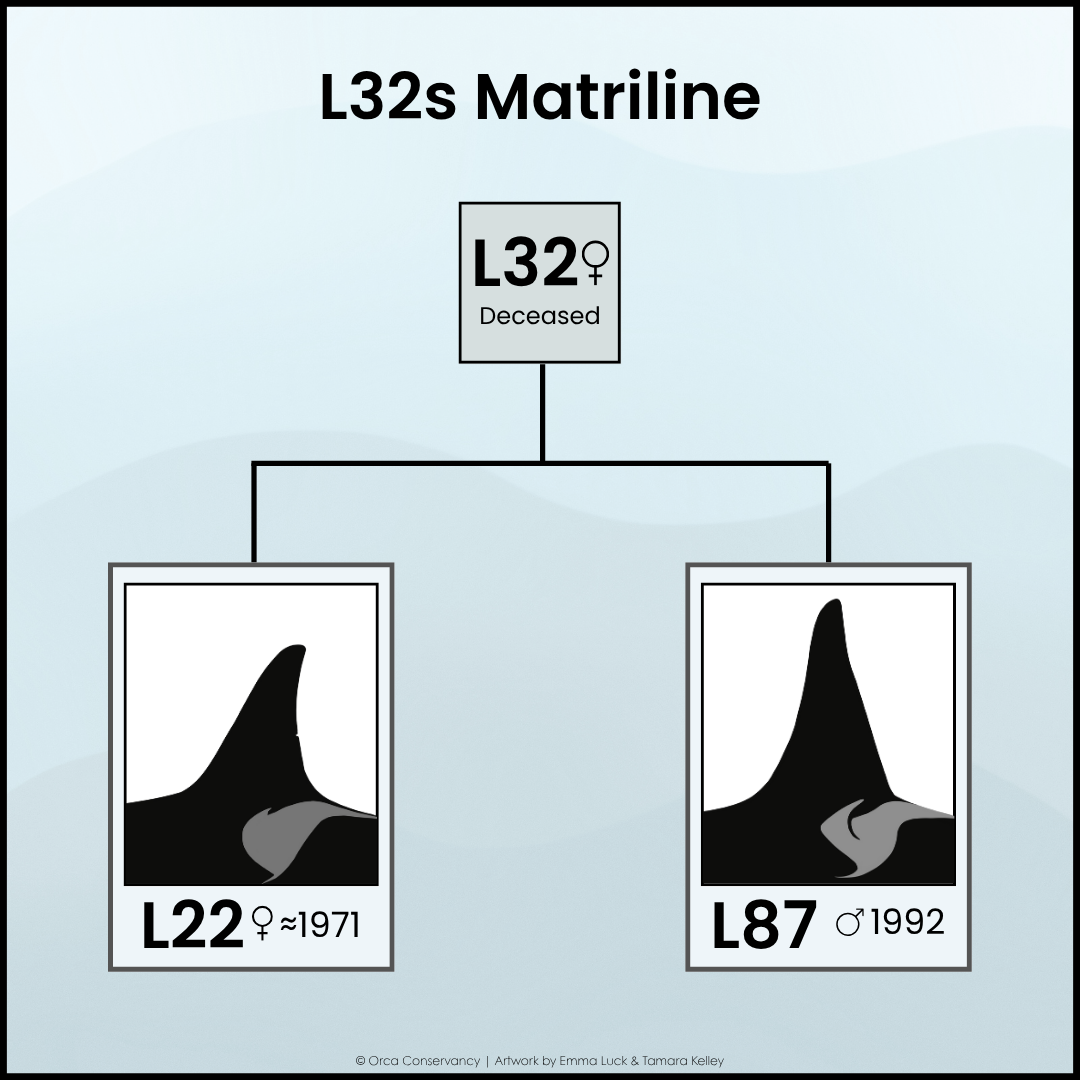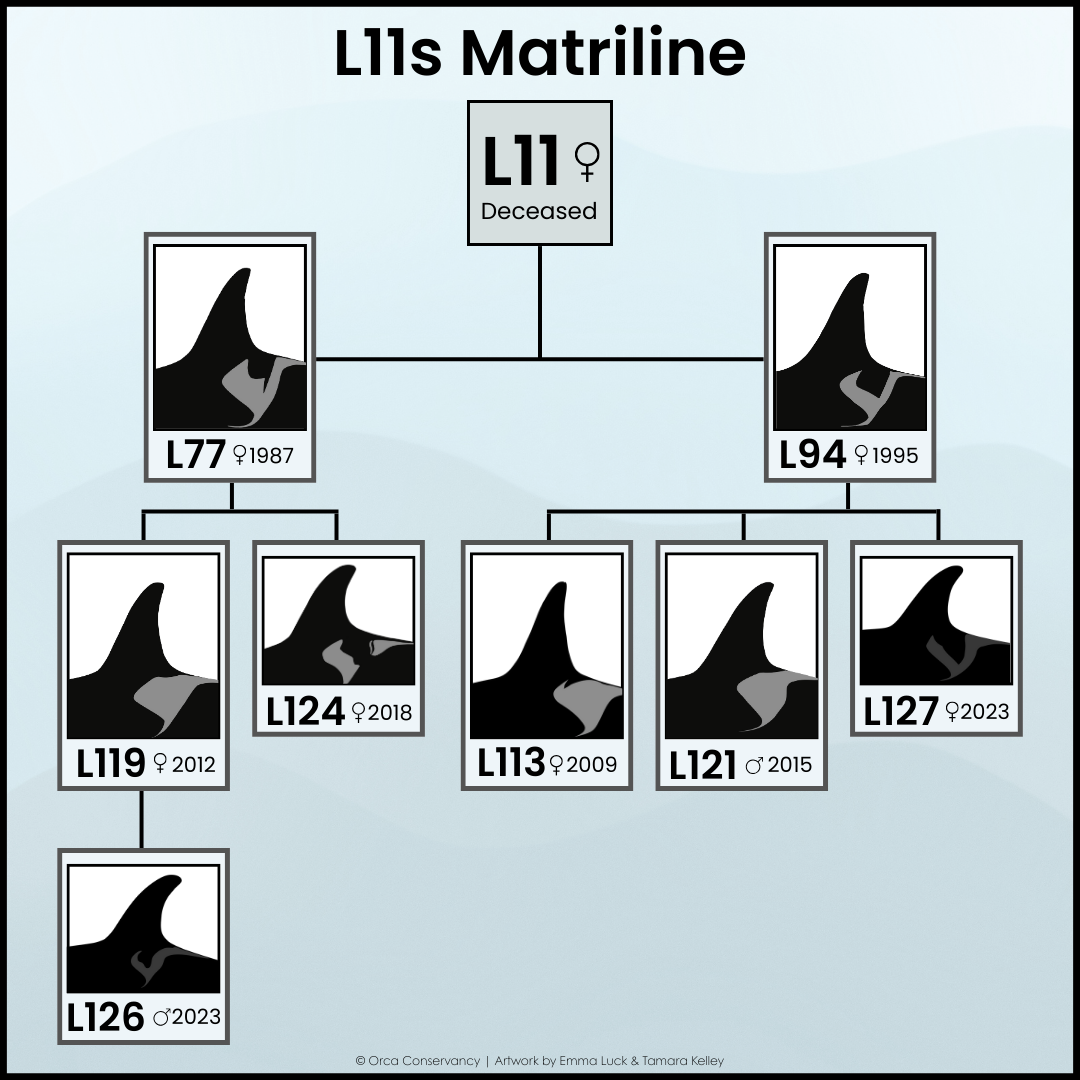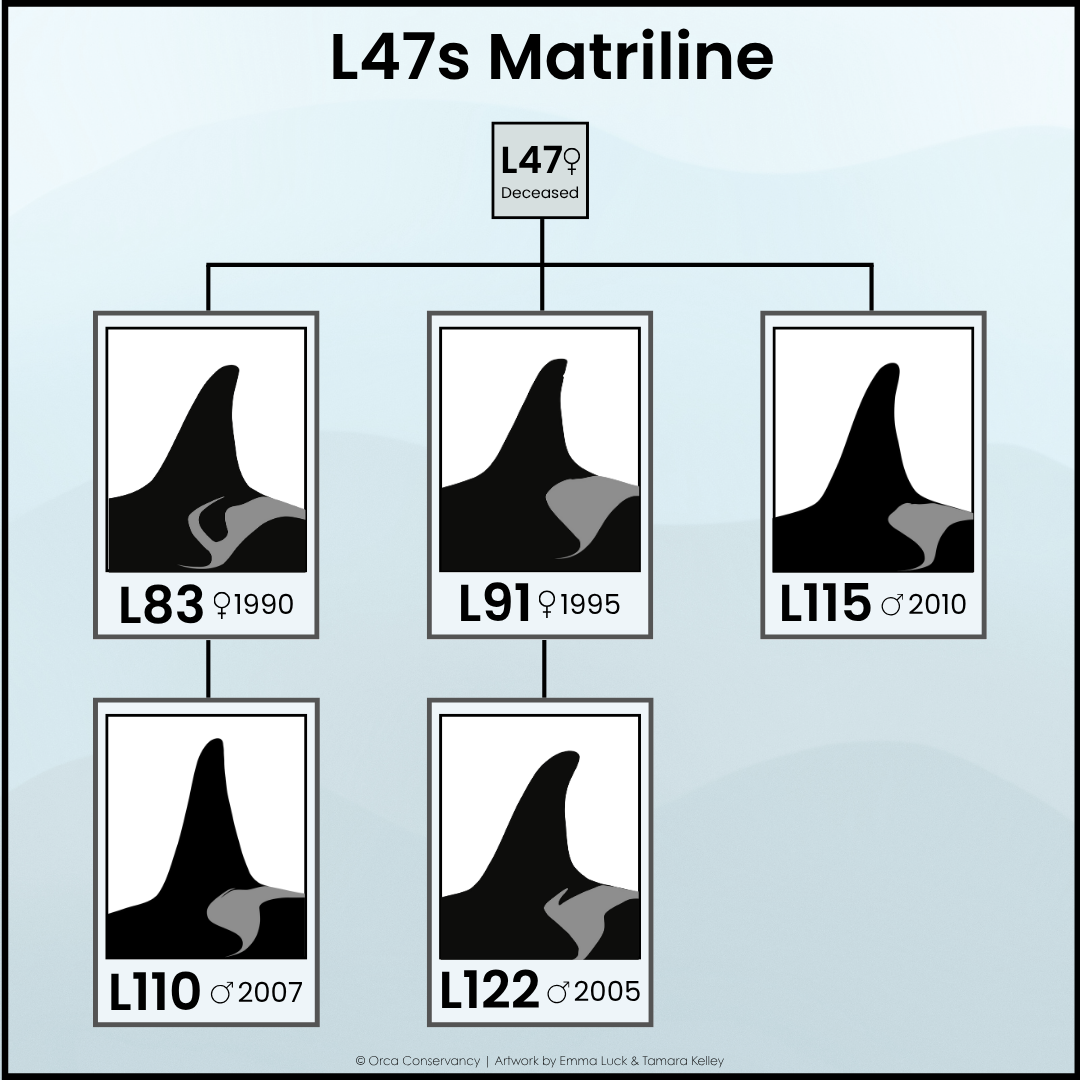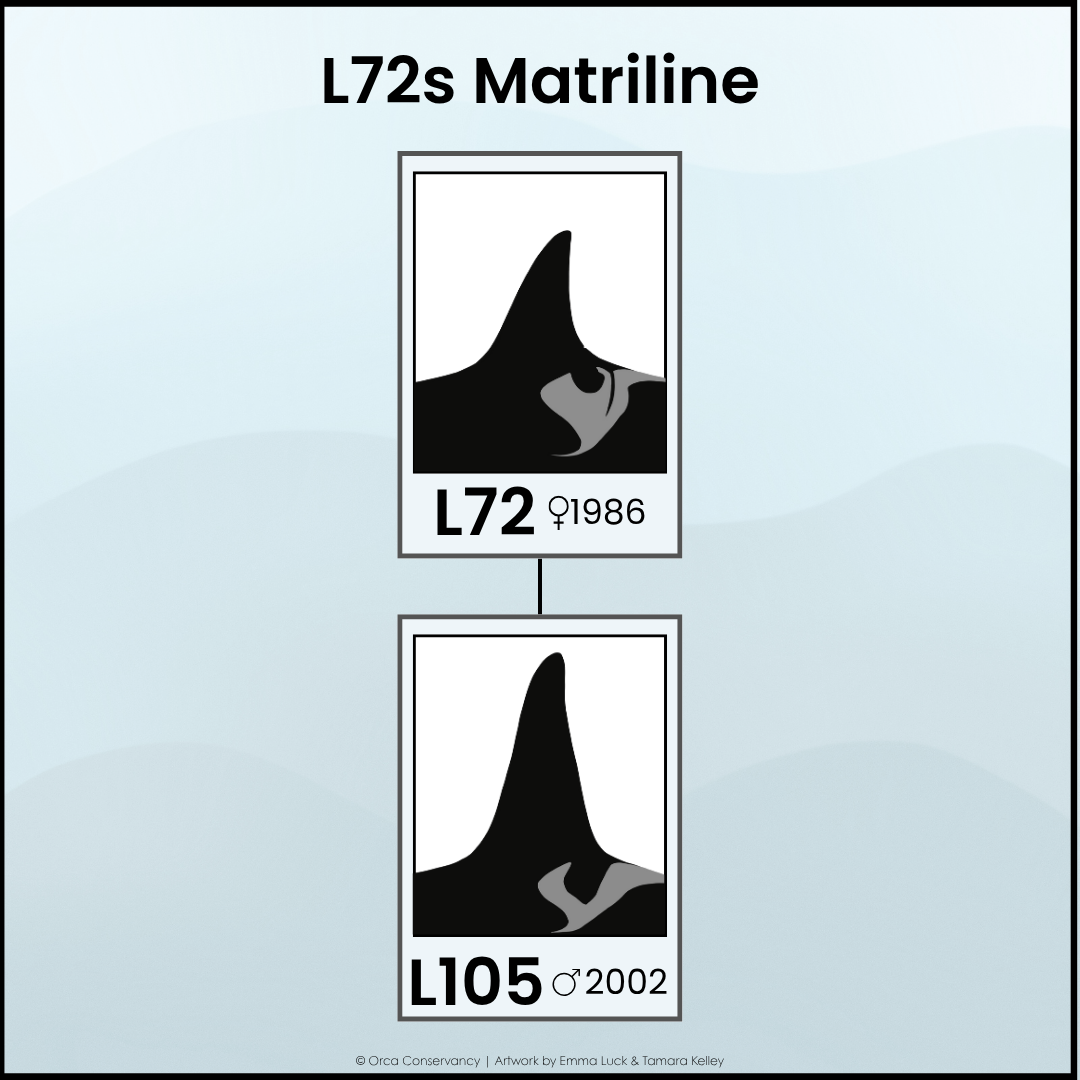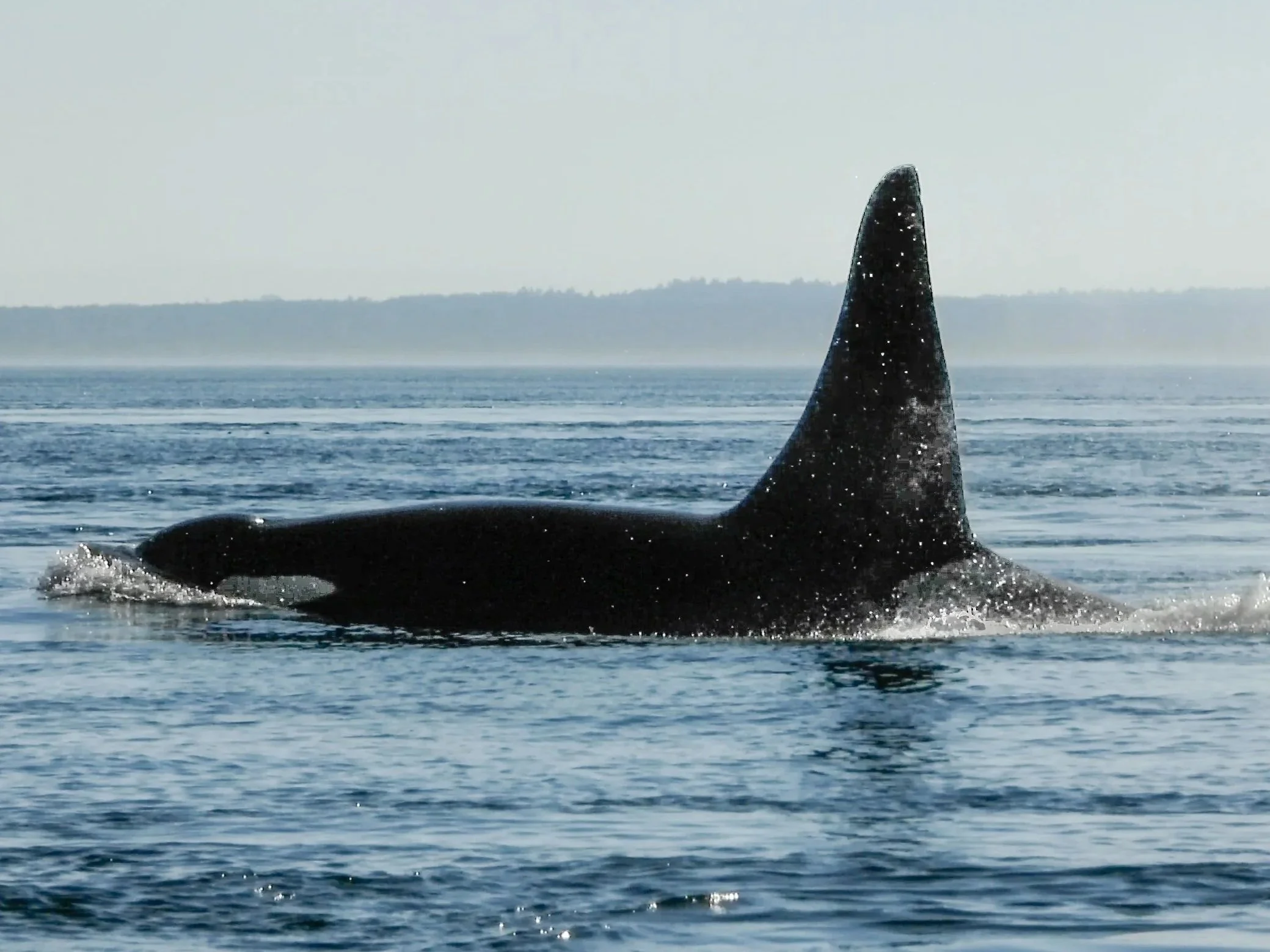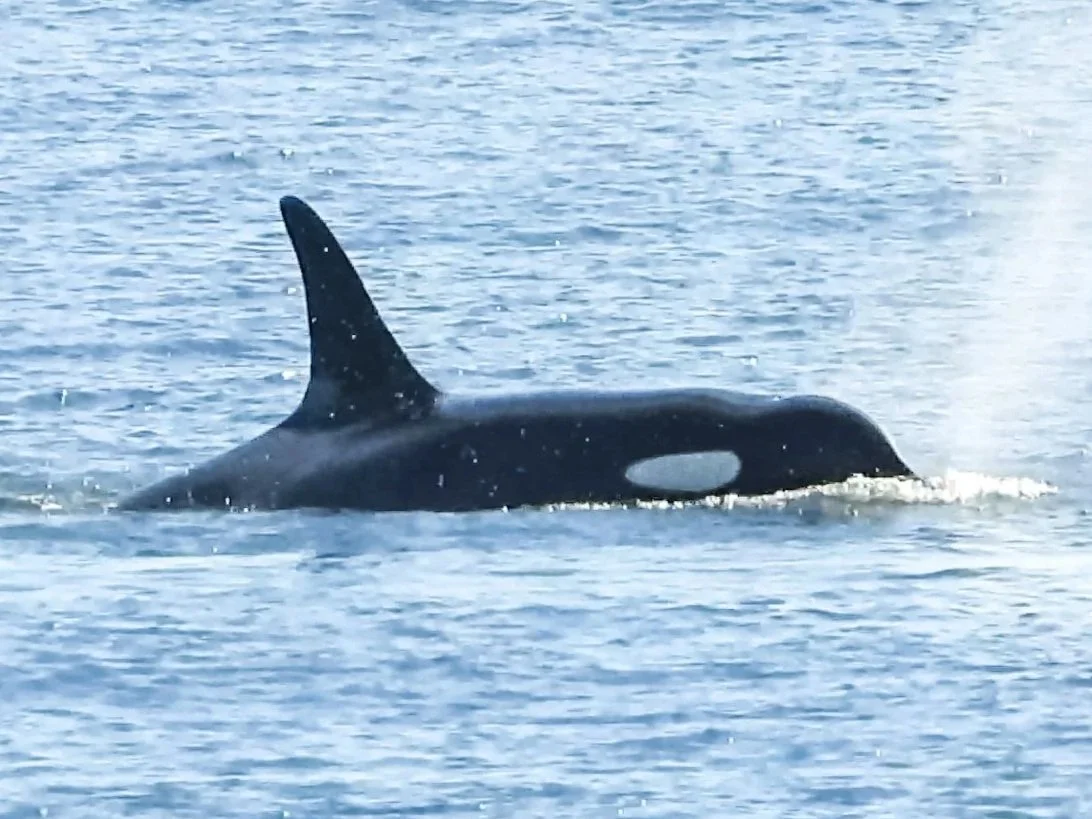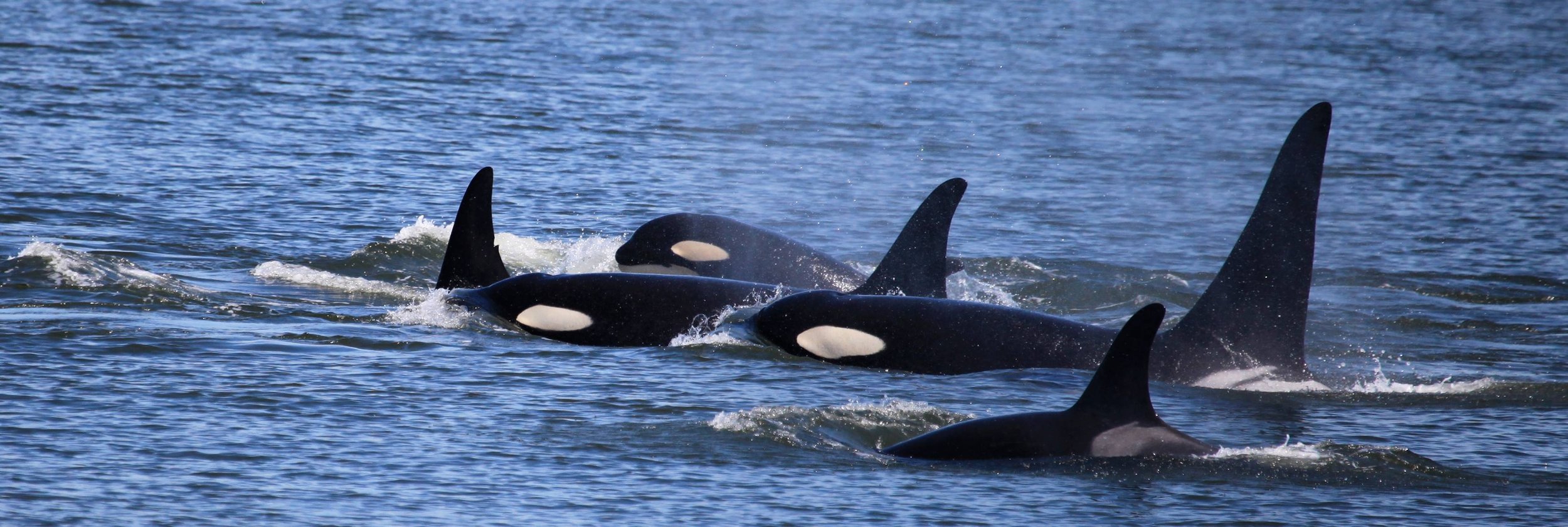
Meet the Southern Resident killer whales
Who are the Southern Residents?
The Southern Resident killer whales are a genetically and culturally distinct population of orcas within the Pacific Northwest and consist of three separate pods: J, K, and L Pods. Like other ecotypes of orcas, the Southern Residents are matriarchal, which means females are the leaders. Within each pod, there are separate family sub-groups or matrilines that are centered around the older females (grandmothers and mothers).
Each matriline is identified by the eldest female within the group. In most cases, both males and females will spend the entirety of their lives with their mother (and maternal grandmother if she is still alive). Occasionally matrilines will separate to socialize or breed with other matrilines or pods. There have been a few instances of Southern Residents switching matrilines due to the loss of their mothers or grandmothers, and in one unique case, an orca (L87) has been observed switching pods entirely, though it is not entirely understood why.
Diet
Southern Resident orcas feed exclusively on fish, with salmon making up the majority of their diet. An adult orca needs an estimated 200-385 lbs of fish daily, which is roughly around 4% of their body weight. The preferred prey of Southern Residents is Chinook salmon, also known as King salmon, but studies show they also prey on chum salmon, and smaller percentages of sockeye salmon, coho salmon, lingcod, halibut, and steelhead.
An interesting fact about Residents is that while they hunt individually, they prey share amongst their immediate families. Females were observed as the most likely to prey share, especially with offspring. Some theorize that this is likely the reason that males have higher mortality rates once their mothers and grandmothers have died.
Naming
Southern Residents are given an ID when they are born and cataloged by the Center for Whale Research. The unique ID they are given is alphanumeric and starts with the letter of the pod they are born in and followed by the number order in which they were cataloged. For example, the calf J57 was born into J Pod, and was the 57th member of J Pod to be identified, hence the ID J-57.
Many familiar with the Residents will also recognize individuals by their “nicknames”. Typically, the whale nicknames are assigned to the individual orcas by the Whale Museum and are often voted on by the public. On some occasions, the names will be in honor of prevalent researchers or conservationists within the community, while others may be named after locations, pets, fictional characters, and even snacks.
Assigning nicknames to the Southern Residents was a result of a conservation movement to block a proposed capture of L Pod within Canadian waters during the capture era in the 1970s. Conservationists believed that if local residents became familiar with the orcas by name, they would be more emotionally connected and therefore want to protect whales from capture. Each member was given a nickname outside of their alphanumeric IDs, and this strategy proved to be effective. Residents petitioned and successfully blocked the proposed capture of members of L Pod, and since that time now all Southern Residents, Northern Residents, and Transients have been assigned nicknames.
Current Population Count:
J Pod: 27*
K Pod: 14
L Pod: 33
Total: 74*
*Note: This total does not include the calfJ64 who is presumed deceased.
NOW AVAILABLE
free digital copy of the
J Pod Eye Patch Guide | 2025
Printed booklets available in the
Orca Shop.
J Pod
J Pod is easily one of the most recognized of the Southern Resident pods, due in part to their range. During any given time of the year, J Pod can appear in the waters off the west side of San Juan Island, Southern Gulf Islands, central and south Puget Sound proper, and Georgia Strait. Historically J Pod would frequent Haro Strait along San Juan Island during mid-spring through the summer, and spend time in Puget Sound in the late summer, and early spring. However, there has been a shift in sightings and the timing of J Pod’s presence in the areas based on salmon returns. In the year 2021, J Pod was missing from San Juan Island for months, showing up intermittently throughout the summer, and spending late fall and early winter foraging in southern Puget Sound, which correlated with the late salmon runs. During the winter J Pod tends to stay in the coastal areas between Washington and Vancouver Island, Canada.
Total Members: 27
Matrilines:
J11s
J14s
J16s
J17s
J19s
J22s
J11s
J27 Blackberry (male, born 1991)
J31 Tsuchi (female, born 1995)
J39 Mako (male, born 2003)
J56 Tofino (female, born 2019)
J14s
J37 Hy’Shqa (female, born 2001)
J40 Suttles (female, born 2004)
J45 Se-Yi-Chn (male, born 2009)
J49 T'ilem I'nges (male, born 2012)
J59 Sxwyeqólh (female, born 2022)
J63 (female, born 2025)
J16s
J16 Slick (female, est. birth 1972)
J26 Mike (male, born 1991)
J36 Alki (female, born 1999)
J42 Echo (female, born 2007)
J17s
J35 Tahlequah (female, born 1998)
J44 Moby (male, born in 2009)
J46 Star (female, born 2009)
J47 Notch (male, born 2010)
J53 Kiki (female, born 2015)
J57 Phoenix (male, born 2020)
J19s
J19 Shachi (female, born 1979)
J41 Eclipse (female, born 2005)
J51 Nova (male, born 2015)
J58 Crescent (female, born 2020)
J62 (female, born 2024)
J22s
J22 Oreo (female, born 1985)
J38 Cookie (male, born 2003)
The J11s
J27 Blackberry (male, born 1991)
J27 Blackberry is an adult male born in November of 1991. J27 is one of the most popular Southern Resident killer whales and is easily recognized by his tall dorsal fin and fully open saddle patch on the left side, while the saddle on the right is only slightly open with a short, pointed finger.
J27 has a very close relationship with his sister J31 and younger brother J39, who all lost their mother J11 in 2008. After the loss of their mother, J27 and his sister helped raise their younger brother who was only 5 years old.
J27 also is close to J26, a male born around the same time as him, and they are seen traveling together from time to time.
Genetic studies reveal that J1 Ruffles is the likely father of J27.
J31 Tsuchi (female, born 1995)
J31, known as Tsuchi, got her name from the Japanese word for “melon-headed whale”, a North Pacific cetacean species sometimes seen off the Washington coast.
A unique trait of J31 is the unique jagged pattern behind the subocular notch, located below her eye and eye patch.
In 2016 J31 was observed carrying a deceased calf which was likely her first. She had a second calf J56 in May 2019.
Tsuchi has a close relationship with her two brothers J27 and J39 who all lost their mother J11 in 2008. After the loss of their mother, J31 and older brother J27 helped raise their younger brother J39 who was only 5 years old when they lost their mother.
J39 Mako (male, born 2003)
J39 was named Mako, which is derived from the Japanese word “mako kukira” which translates to sperm whale.
J39 was first seen on April 3, 2003, and is the youngest of J11’s offspring. J39 was only 5 years old when he lost his mother. He has a very close relationship with his older siblings J27 and J31, who helped raise him after the loss of J11. In most cases, young killer whales do not survive after the loss of their mother. The survival of J39 is a testament to the care and success of his two older siblings whom helped raise and care for him.
In August 2015 Mako was spotted with fishing gear logged in his mouth. Shortly after he was spotted again and the gear was gone with no apparent indications of injury.
In June 2023 photogrammetry research revealed J39 to be in poor body condition showing sings of low body mass. J39 was one of ten whales deemed vulnerable.
J56 Tofino (female, born 2010)
J56 Tofino was first seen in May 2019, off the coast of Tofino, B.C., and is the first surviving calf of J31. It took researchers a while to confirm the birth mother, as J40 and J46 were often seen traveling alongside the new calf. A few months after being seen J56 was confirmed to be a female.
Prior to the birth of J56, J Pod had gone 3 years without a successful calf. J56 represented a beacon of hope to many, as she was the first calf following a series of tragic losses and no new births.
The name Tofino comes from the location she was first seen and was chosen from a voting contest held by The Whale Museum.
In 2023 data collected by photogrammetry research measuring body mass revealed J56 in BC1 status, which is very poor condition. For the third consecutive year, J56 was documented as BC1 status and deemed vulnerable due to her low body mass likely caused by nutritional stress.
The J14s
J37 Hy’Shqa (female, born 2001)
J37 Hy’Shqa is the oldest of three surviving offspring born to J14 (deceased) and the matriarch of the J14 matriline.
J37 received her name Hy’Shqa, which means “blessing” or “thank you” in Coast Salish, from a traditional potlatch ceremony held by the Samish Nation.
Hy’Shqa is a mother of two, J49 T’ilem I’nges, and the newest member of J Pod, J59, a female calf who was first spotted in March of 2022.
J37 can be identified by her dorsal fin that hooks near the top with a pointed tip, and also has a small bump on the center of the trailing back edge.
J40 Suttles (female, born 2004)
J40 is the great-granddaughter to J2 Granny and is often said to look much like her with a similarly shaped dorsal fin and saddle patch.
J40 developed the reputation of being a famous babysitter. She is often observed traveling with J31 Tsuchi and calf J56 Tofino, who both belong to a separate matriline, the J11s. When J56 was first seen in 2019, it took researchers a few months to determine who the mother was, since both J40 and J31 were constantly seen with J56.
In December of 2023, J40 was photographed with a new calf J60 (male, deceased). It was initially believed that J40 was the mother, however, it was later determined by researchers that J40 was not the mother.
On April 6, 2025, the researchers documented a new calf traveling in the echelon position of J40. The calf, designated J63, was determined to be Suttle’s, making her a first-time mother.
The name Suttles was chosen in the traditional potlatch ceremony held by the Samish Nation, and selected in honor of the late Wayne Suttles, an anthropologist who devoted his career to preserving Coast Salish cultures.
J45 Se-Yi-Chnn (male, born 2009)
J45 was first seen March 3, 2009, and is the youngest of the three surviving offspring of J14 Samish.
Genetic testing revealed that L41 Mega is the father of J45.
Like his siblings, J45 received his name Se-Yi-Chnn from the Samish Nation in a traditional potlatch ceremony. The name Se-Yi-Chnn is Coast Salish for “younger sibling”.
J49 T’ilem I’nges (male, born 2012)
J49 is the first calf born to J37 and is the older brother to J59. He was first seen on August 6, 2012.
Genetic testing revealed that the father of J49 is L79 Skana.
The name T’ilem I’nges means “singing grandchild” in Coast Salish and was chosen in a traditional potlatch ceremony by the Samish Nation.
J59 Sxwyeqólh (female, born 2022)
J59 is the second offspring to J37, and younger sister to J49.
She was first seen on March 1, 2022 and was determined to be less than a week old due to the “lumpy” physical nature that is seen with newborn calves. On May 26, 2022 J59 was confirmed female by an aerial survey conducted by the Center for Whale Research.
The name Sxwyeqólh was announced by the Samish Indian Nation during their traditional potlatch naming ceremony on June 24, 2023, and means “Reason for Hope Child.”
J63 (female, born 2025)
J63 was first seen by shore-based whale watchers, including Orca Conservancy staff member Tamara Kelley, on April 2, 2025, in Central Puget Sound, though the calf wasn't confirmed until several days later. On April 6, 2025, the Center for Whale Research officially documented the calf and identified J40 Suttles as the mother, noting the calf traveling in the echelon position alongside her. J63 is J40’s first known offspring and marks the fourth calf born to the Southern Resident killer whale population within the past 12 months. In early July of 2025, researchers photographed the underside of J63, determining that she is a female.
The J16s
J16 had her last calf J50 Scarlet (deceased) at the age of 43, which is beyond the normal age of a reproductive female. When born, J50 had rake and bite marks indicating a difficult birth that may have required assistance from other whales. Researchers speculated whether or not J16 was the mother due to her age and suspected that her daughter J36 could be the mother. It was later confirmed that J16 was indeed the mother.
J16 has a fully open vertical notch saddle on the right that is almost identical to her daughter J42, while her left saddle is a finger saddle.
J16 Slick (female, est. birth 1972)
J16 Slick was estimated to be born in 1972 to J7 Sucia and is believed to be the oldest whale in J Pod. She was initially presumed to be male.
Slick is one of the most successful mothers in the population and has had a total of 6 offspring, three of which are alive today.
J26 Mike (male, born 1991)
J26 is one of the most recognized orcas of the Southern Residents and a favorite to many. Mike was first sighted in the fall of 1991, shortly after the late Dr. Michael Bigg (pioneer in killer whale research and identification) had passed away.
When J26 was first spotted by researchers he was so young he still had his umbilical cord attached, and researchers were able to see his stomach to confirm his sex. After researchers confirmed he was male, Ken Balcom (Center for Whale Research) a former colleague of Dr. Bigg pointed and shouted, “MIKE!”, thusly giving J26 the name Mike in honor of the late whale researcher.
Prior to the passing of his youngest sister J50, J26 often spent much time with her, even during her ailing health. He was often revered as being as being a good big brother to young J50.
Genetic studies revealed J26 sired a calf, J42, with his mother J16, and had also sired a calf J52 (deceased) with his sister J36. J26 is also the likely father of L118.
J36 Alki (female, born 1999)
J36 Alki was first seen December 18, 1999, and is the second oldest living offspring of J16. Through genetic testing, L41 Mega was identified to be the father of J36.
J36 was named Alki through a newspaper contest and was selected by a committee from the Whale Museum and Center for Whale Research. The name Alki means “future/tomorrow/times to come” in the Chinook language and was chosen because J36 was born close to the new millennium and represented hope and a healthy future for Puget Sound.
J36 has only had one calf, J52 Sonic, who was last seen alive in September 2017. After the loss of her calf, J36 was reported to be looking thin and distressed. In 2021, it was reported through photogrammetry that J36 was pregnant, but was never seen with a calf the following year, leading researchers to conclude she had a failed pregnancy. In June 2023, photogrammetry data revealed J36 to be in late-stage pregnancy.
Sadly, J36’s failure to produce a viable calf continued, and on September 12, 2025, she was observed carrying a deceased calf in Rosario Strait. Based on the size of the neonate, the calf was determined to be full-term or near full-term. It is not clear if the calf was stillborn or died shortly after birth. Because the calf did not survive, it was not designated an alphanumeric ID.
J42 Echo (female, born 2007)
J42 is the youngest surviving offspring of J16 and was first seen on May 2, 2007, at less than a week old. Genetic testing confirmed J26 (older brother to J42) to be the father, making J42 inbred.
The name Echo comes from the word “echolocation,” which is a technique used by orcas to hunt and navigate. J42 has a very distinguished open hook saddle on both sides, with the right appearing almost identical to that of her mother, J16’s saddle.
In December of 2023, a new calf (male, deceased) was documented traveling in J Pod and given the alphanumeric ID J60. Prior to the death of the calf, he had been documented traveling in the echelon position of J42. Researchers had determined J42 as a possible mother, but ultimately ruled her out due to the timing she had been documented pregnant, which did not align with the birth of J60.
On September 18th, 2025, J42 was spotted with a new calf by researchers from SeaDoc Society and San Diego Zoo Wildlife Alliance, who were collecting samples from J Pod in Puget Sound. It was later determined that J42 is the mother based on observations of nursing behaviors and because J42 had previously been documented in late-stage pregnancy. The birth of the calf J64 marks the first viable calf born to J42. She had been previously documented pregnant in both 2018 and 2024, with both those pregnancies failing.
Photo by Brittany Philbin
J64 (sex unknown, born 2025) *Presumed deceased
J64 was first seen on September 18th, 2025, in Puget Sound, when researchers from SeaDoc Society and San Diego Zoo Wildlife Alliance were collecting samples from J Pod. Before the discovery of the new calf, Orca Conservancy and Orcasound received an AI detection early on September 18th from our Sunset Bay hydrophone, of what was determined to be a very young whale, based on the mispronounced calls, and is likely audio of J64. (Listen here)
The calf was seen traveling with J42, who was later confirmed to be the mother based on behavioral signs of nursing, and that J42 had been documented in late-stage pregnancy prior to the birth of J64. This is the first viable offspring born to J42.
The calf has not been seen since September, and is presumed deceased based on its young age and dependence on its mother.
The J17s
J35 Tahlequah (female, born 1998)
J35 Tahlequah is the leader of the J17 matriline which consists of her two surviving siblings, niece, and two offspring.
J35 was born in 1998 and was the second oldest offspring of J17 (deceased) and one of three surviving offspring of J17.
With the loss of J35’s older sister in 2016 followed by the loss of her mother in 2019, J35 was placed in the position of being the matriarch of the J17s. Despite multiple devastating losses, J35 has filled the role of the matriarch and has a close bond with her family, especially her two sons J47 and J57.
Many will remember J35 from when she made international headlines and gripped the world with what was labeled the “Tour of Grief”. In the summer of 2018, J35 gave birth to a female calf that died shortly after birth. J35 carried the dead calf for a total of 17 days for over 1,000 miles. A week after the loss of the calf, family members began taking turns carrying the dead calf to allow J35 to rest.
In the summer of 2020 J35 made headlines again, this time with more positive news. Photogrammetry research revealed that J35 was pregnant again. In September 2020 J35 was seen with a young calf J57.
On December 20, 2024, J35 was photographed by local photographer Brittany Philbin with a brand new calf. Researchers determined the calf to be female and confirmed J35 as the mother. The calf was assigned the alphanumeric ID of J61. Sadly, the calf did not survive and was declared deceased on December 31, 2024. The following day, J35 was seen carrying the body of J61, much like she did in 2018.
J44 Moby (male, born 2009)
J44 Moby was first seen on February 6, 2009, and was the third offspring born to J17 (deceased). A few months after being seen by researchers, J44 was confirmed to be male. Genetic research revealed that J44 is the offspring of L41 Mega.
J44 has a close bond with his niece J46 and nephew J47 who are all close in age and often seen together.
In June of 2023, J44 was listed as a vulnerable whale when photogrammetry revealed him to be in BC1 status with a low body mass..
J46 Star (female, born 2009)
J46 Star is the oldest and only surviving calf of J28 and was first seen on November 11, 2009. Genetic testing revealed J46 to be sired by J1 Ruffles, who also sired her mother J28, making her inbred.
In October 2016 J46 lost both her mother J28, followed immediately by the loss of her younger brother J54 who was only ten months old and nursing, unable to survive without his mother. It was observed that J46 attempted to care for J54, offering him salmon and bringing him up to the surface.
In October 2020 J46 was photographed in Southern Puget Sound and appeared to look very far along in pregnancy, but was never officially confirmed by researchers or photogrammetry. J46 was seen again in February of 2021 but not observed to be pregnant, presumably having an unsuccessful pregnancy and losing the calf.
J46 has a close bond with her uncle J44 and cousin J47 who are all close in age. J46 is also very close with J31 and her daughter J56 who are a part of the J11 matriline. When J56 was first born, it took researchers a few months to determine who the mother was, since both J46 and J40 were often seen traveling with the young calf. Since the birth of J56 in 2019, J46 can often be seen traveling with J31 and J56.
In December 2023 a new calf, J60 (male, deceased) was documented with J Pod. The calf had been seen with multiple different females prior to his death. Researchers later determined J46 to have been the probable mother based on records of her pregnancy which aligned with the birth of J60. It’s unclear why J60 was never seen with J46, but it could be a case of inability to nurse or calf rejection.
J47 Notch (male, born 2010)
J47 Notch is a male killer whale and was first seen on January 3, 2010, and is the first offspring of J35.
The name Notch came from the prominent notch on the center trailing back edge of his dorsal fin caused by an injury he acquired at a young age. The cause of the injury is unknown. J47 is a sprouting male and is very easily identified from the notch on his dorsal fin. Another distinguishing feature of J47 is his fully open saddle on the right side, while the left has a mostly closed saddle with a short and pointed finger.
When J47 was younger he was often observed spending much of his time with his uncle J44 and cousin J46 and wasn’t always seen with his mother J35. After the loss of J35’s calf in 2018, J47 spent much more time with his mother. J47 became an older brother in 2020 to J57. Since the birth of J57, J47 has developed a close bond with both his mother and younger brother and is seen much of the time traveling with the two of them and playing with young J57.
J53 Kiki (female, born 2015)
J53 Kiki was first seen on October 24, 2015, and was born during the “baby boom” of 2014-2015. She is the youngest offspring of J17 and is one of the three surviving offspring.
Kiki, which is short for Kikisoblu, was named in honor of Chief Seattle’s daughter (her original name) and is of the Lushootseed language, a native language that was used mostly in western Puget Sound.
Through genetic testing and studies, it was discovered that J53 was sired by L41 Mega.
J57 Phoenix (male, born 2020)
J57 Phoenix was first seen on September 5, 2020, and is the second calf of J35. At the time he was first discovered, he was presumed to be a few days old based on the physical nature of his body. A few weeks after J57 was seen, he was confirmed by researchers to be a male.
The birth of J57 came two years after what was called the “Tour of Grief” when J35 lost her calf and carried it around for 17 days. J57 surviving and appearing to be a healthy calf was very symbolic and brought many people hope after such a traffic event.
In December 2020, The Whale Museum hosted a naming contest where the public could vote on three different names for the two newest calves in J Pod, including J57. The winning name was Phoenix, which was chosen in part for the folklore around phoenixes and the symbolism of rising from the ashes.
J57 is one of four calves born into J Pod within the past 4 years. He appears to enjoy spending time and playing with his older brother J47. He can also be seen frequently traveling and playing with J58 who was born around the same time as him. Over the summer of 2022, he was seen spending much time with J58 and at times being babysat by J41 who would take turns with J35 babysitting the two.
The J19s
J19 Shachi (female, born 1979)
J19 Schachi is the matriarch of the J19 matriline, which consists of her daughter and two grandchildren. J19 was first seen in the spring of 1994.
Prior to the birth of her own calves, J19 had the reputation of being a “babysitter”, and would often look after other whale’s calves.
J19 had her first calf J29 in 1993 who died just a few weeks after birth. J19 had a second calf, J41, in 2005 who then gave birth to two calves, making J19 a grandmother. J19 has played a major role in the lives of her grandchildren, assisting J41 in raising the calves.
In September 2021 researchers announced that J19 was pregnant, but several months later in March 2022, she was no longer pregnant and not seen with a new calf, leading researchers to believe she lost her pregnancy.
After the loss of J2 Granny in 2016, who was the matriarch and leader of all of J Pod, many wondered who would fill that role. Over the course of the past several years, J19 appears to be the matriarch filling that role and is often seen at the very front of the line leading J Pod, altering the directional course, or summonsing the entire pod through tail slaps and other surface behaviors.
J41 Eclipse (female, born 2005)
J41 Eclipse is the second and only surviving offspring of J19. She was first seen July 1, 2005.
At only ten years old, J41 gave birth to her first calf J51, who her mother J19 helped her raise. It’s quite unusual for orcas to reproduce at such young age, and J41 was the youngest known mother to the Southern Resident killer whales.
J41 had a second calf, J58, in September 2020.
Employees and passengers aboard a whale-watching tour with Orca Spirit Adventures witnessed J41 giving birth to J58. The account describes that J41 was alone near Race Rocks, diving underwater for several minutes and resurfacing with a black mass on her rostrum. There was concern of distress and fear that J41 may be entangled, but after a while, the crew and passengers were able to determine the object they were seeing was a brand new calf. Images were then sent to the Center for Whale Research and were confirmed to be a new calf to J41.
On December 30, 2024, J41 and J19 were observed traveling with a newborn calf tucked between the two of them. This calf was later designated J62, and determined to be the third offspring born to J41.
J51 Nova (male, born 2015)
J51 Nova was first seen on February 12, 2015, and is the eldest of the two offspring born to J41. When J51 was first born, researchers believed J19 (the grandmother of J51) to be the mother based on the very young age of ten years of his mother. Because of the young age of his mother, J19 played an important role in helping raise J51. The survival of J51 was credited to the assistance of J19 in helping raise the young calf. To this day, J51 often travels alongside his grandmother J19.
Nova, like his mother and younger brother, received a name related to the solar system.
At just a few months old, J51 appeared to be very close with J47, who is five years older in age. The two of them were often observed having “play dates”. The two also became older brothers around the same time when each of their mothers gave birth to calves in September.
J58 Crescent (female, born 2020)
J58 Crescent was born on September 24, 2020. The birth of J58 was witnessed by crew and passengers aboard a whale watch tour with Orca Spirit Adventures. Photos were later sent to the Center for Whale Research which confirmed the new calf to be the second offspring of J41.
In March 2021 researchers were able to confirm that J58 is a female. The birth of females into the Southern Resident killer whale population is especially important to ensure that the population will continue to survive with breeding females.
The name Crescent came from the Whale Museum which conducted a vote to name the newest calves including J57. Like her mother and older brother, J58 received a name related to the solar system. The winning name Crescent, which is a lunar phase of the moon, was selected for the symbolism of the beginning of a new moon and its ties to a new life of a baby orca.
J58 appears to be quite close with J57, a male calf born the same month as her. The two of them can often be seen playing or traveling together, while their mothers take turns babysitting the two of them.
J62 (Female, born 2024)
J62 was first discovered by local whale watchers on December 30, 2024, shortly after the death of calf J61. Initially, J62 was believed to be J61 until it was discovered that J61 was deceased and being carried by J35. J62 had been documented traveling with the J19s for a few encounters, and researchers later determined J41 Eclipse to be the mother. J62 is the third surviving calf born to J41 and has two older siblings, J58 and J51. On February 8, 2025, researchers photographed the young calf's belly and determined it to be a female. J62 has yet to be given an official nickname.
The J22s
J22 Oreo (female, born 1985)
J22 Oreo is the matriarch and last surviving female of her matriline. J22 comes from a large extended family group that was formally known as the J9 Subgroup, which included her mother, J10.
J22 was first seen in the winter of 1985. Through genetic studies, it was revealed that J22 was one of many calves sired by J1 Ruffles.
In 1998, J22 had her first calf, J34 Doublestuff (deceased), followed by her second calf, J38 Cooki,e in 2003. In December 2016, the first calf of J22 was found deceased, with the cause of death being blunt force trauma.
J22 received the name Oreo from the Whale Museum. Both her calves received names related to Oreo cookies to match their mother’s name.
The J22 matriline appears to have a close bond with the J11 matriline and travels together frequently. J22’s surviving calf J38, is the same age as J39, and J22 would often be observed babysitting the two young boys.
J38 Cookie (male, born 2003)
J38 Cookie was first seen in early January 2003 and is the only surviving calf of J22. It took nearly six years for researchers to determine the sex of J38, and by July 2009 he was determined to be male by the Center for Whale Research.
The name Cookie was chosen by The Whale Museum and was selected to keep with the theme of the popular cookie brand as his family, Oreo, and Doublestuff.
J38 often associates with J39 from the J11 matriline, who is a male that is a similar age. The J22s often travel with the J11s, and the two young males appear to be quite close. When they were both calves, J22 the mother of J38 was often seen “babysitting” the two young males.
J38 is easily identified by his sprouting dorsal fin, which is tall and wide with a distinguished hook shape that rounds at the top. His saddle patch is similar to that of his mothers with a noticeable finger on both the left and the right saddles.
K Pod is the smallest pod out of the three Southern Resident pods. Unlike J Pod, the range of K Pod is more vast ranging from British Columbia, Canada, all the way down to Northern California. Historically, during the Spring and Summer months, K pod was known to frequent the west side of San Juan Island, chasing the Chinook salmon runs returning to the Fraser River in Canada. In March of 2025, K Pod made two separate visits to Monterey Bay, California. Since the decline of the salmon, they spend far less time in the Salish Sea. In May of 2022, a new calf was spotted with K Pod off the Oregon Coast. The new calf, K45, is the first calf born into K Pod since K44 Ripple in 2011. K44 was declared deceased in September 2022, K34 was declared deceased in 2024, and K26 is currently missing and expected to be declared deceased on the upcoming population census.
K Pod
Total Members: 14
Matrilines:
K12s
K13s
K14s
K16s
K12s
K12 Sequim (female, est. birth 1972)
K22 Sekiu (female, born 1987)
K33 Tika (male, born 2001)
K37 Rainshadow (male, born 2003)
K43 Saturna (female, born 2010)
K13s
K20 Spock (female, born 1986)
K27 Deadhead (female, born 1994)
K38 Comet (male, born 2004)
K45 Prosper (female, born 2022)
K14s
K14 Lea (female, born 1977)
K36 Yoda (female, born 2003)
K42 Kelp (male, born 2008)
K16s
K16 Opus (female, born 1985)
K35 Sonata (male, born 2002)
The K12s
K12 Sequim (female, est. birth 1972)
K12 Sequim is a female orca estimated to have been born around 1972, making her around 50 years old, the oldest female in K Pod. She is a very successful mother and has had five total offspring, three of which are still alive (K22, K37, K43), and three grandchildren, one of which is still alive (K33).
The name Sequim comes from the Makah native village on the Olympic Peninsula. The word Sequim is of the Klallam language and translates to “a place for going to shoot” in reference to the Sequim-Dungeness Valley which was a land that may have once served as an important hunting ground for tribal peoples.
When J1 Ruffles and J2 Granny were alive, K12 appeared to have a close relationship with the two orcas, and would often spend time with the J2 matriline in the inland waters during the summer months.
In the 2021-2022 winter season, the eyepatch of K12 was featured on the base of the Orca snowboard by Lib Tech and professional snowboarder Travis Rice. K12’s eyepatch was selected as the base graphic due to the significance of her name to Lib Tech, whose eco-conscious factory and headquarters are based in Sequim, Washington.
K22 Sekiu (female, born 1987)
K22 Sekiu is a female born in 1987 and is the first of five offspring to K12, and one of three offspring alive today.
Like her mother, K22 received a name that came from a location on the Olympic Peninsula. The name Sekiu is named after a community and historic fishing village on Clallam Bay off of the Strait of Juan de Fuca.
K22 has had two total calves, one of which is alive today. Her first and only living calf, K33, was born in January 2001. Her second calf K41 was first seen in August 2006 and last seen in December 2006.
In October 2006 K12 lost her sister K28 who was the mother of the young calf K39. After the loss of her sister, K22 had cared for the orphaned calf, but sadly the calf went missing and was presumed deceased later that month.
The right saddle patch of K22 is a very distinguishable and open saddle patch that looks very similar to that of K20’s. Her left saddle is slightly less open with a deeper pigment. Both left and right saddles have what appear to be subtle black sweeping lines that break up the white pigment at the base of the back.
K33 Tika (male, born 2001)
K33 Tika is a male orca first seen early January in 2001. He is the first and only surviving calf to K22. Genetic studies have revealed L41 Mega to be the father of K33.
The name Tika is of the Chinook First Nations language and translates to mean “swift”.
In the 2022-2023 winter season, the eyepatch of K33 was featured on the base of the Orca snowboard by Lib Tech and professional snowboarder Travis Rice. K33’s eyepatch was selected as the base graphic due to the significance of his name to Lib Tech.
K33 is the uncle of K37, and grandson of K12, who were the orcas used in the previous years’ models of the popular snowboard, who are both named after the location and headquarters of Lib Tech, Sequim, Washington.
K33 is a mature male with a tall dorsal fin, and a closed saddle patch on his left and right side.
K37 Rainshadow (male, born 2003)
K37 Rainshadow is a male orca first seen in January 2004. He is the fourth calf born to K12, and one of three surviving offspring. Through genetic testing J1 Ruffles was revealed to be the sire of K37.
On September 11, 2020 K37 was tagged by researchers from NOAA Fisheries with a suction cup DTAG to collect data on killer whale behavior. The tag was intended to stay on K27 for a total of 24 hours and was designed to naturally fall off and transmit a signal for retrieval.
The tag has fallen off over the night somewhere within the Salish Sea leading researchers on a difficult search for the lost tag, especially with the poor visibility caused by the wildlife smoke during that time and border closures from the Coronavirus Pandemic. With the help of Canadian scientists, the DTAG was able to be retrieved. Researchers determined the tag had fallen off only an hour earlier than intended, meaning it had succeeded in collecting crucial overnight data.
In the 2020-2021 winter season, the eyepatch of K37 was featured on the base of the Orca snowboard by Lib Tech and professional snowboarder Travis Rice. K37’s eyepatch was selected as the base graphic due to the significance of his name to Lib Tech. The location of the Lib Tech eco-conscious factory and headquarters is based in Sequim, Washington which is in a small region on the Olympic Peninsula that experiences the rain shadow effect. Sequim, is also the name of K12, the mother of K37.
In the summer of 2024, K37 appeared with a fresh notch on the center of his back dorsal fin. The imprint and size of the wound suggest it was caused by killer whale teeth.
K43 Saturna (female, born 2010)
K43 Saturna is a female orca who was first seen on February 21, 2010. She is the last calf born to K12, and is one of the three surviving offspring.
Genetic studies conducted by multiple agencies concluded that J1 Ruffles sired a known 16 calves, including K43, making Ruffles the father to Saturna.
The name Saturna comes from Saturna Island, which is a small mountainous island that is part of the Southern Gulf Island chain in British Columbia, Canada that the Southern Residents often pass along their way to forage for salmon runs at the Fraser River.
K43 has an open saddle patch on both her left and right side, that features a whisky black pattern along the ridge of her back that resembles painting brush strokes.
The K13s
K20 Spock (female, born 1986)
K20 Spock is a female orca born in early 1986. She is the first calf born to K13, and one of three surviving offspring.
The name Spock was chosen by The Whale Museum and comes the character Spock from the famous television show Star Trek.
In K20’s early years, researchers believed K20 to be a male because of the shape of her dorsal fin, which looked similar to that of a sprouting male orca. In December 2004, K20 had her first calf K38, confirming her sex as a female.
On April 28, 2022, K20 was filmed with a small calf off the coast of Oregon by local fisherman. During July when K Pod returned to the Salish Sea, researchers were able to confirm that K20 is the mother to the newest calf, and assigned the new calf the alphanumeric ID of K45. The newest calf K45 was widely celebrated as it is the first calf born into K Pod since 2011.
Spock is very easy to recognize, she has a pigmented saddle patch that is open on both the left and right sides, and her dorsal fin has a “sprouting shape” that has a straight trailing edge along the back, similar to that of a male dorsal fin.
K27 Deadhead (female, born 1994)
K27 Deadhead is a female orca who was born in 1994. She is the fourth offspring born to K13, and one of three surviving calves. Genetic testing revealed J1 to be the sire of K27.
The name Deadhead was chosen by The Whale Museum and was selected in honor of the passing of Jerry Garcia lead guitarist and vocalist of The Grateful Dead, who passed away in 1995 the year after K27 was born. There is a misconception that the name Deadhead is a reference to a sailing or boating term deadhead, which is a log that has been swept to sea, but in the case of K27 the name Deadhead is in reference to Grateful Dead fans who are also called “dead heads”.
K27 had her first and only calf K44 in July 2011, who was later declared deceased by the Center for Whale Research in August 2022 after he was not seen with his mother or pod during multiple visits to the Salish Sea.
Unlike her siblings who both have open saddle patches on both sides similar to their mother K13, K27 has a closed saddle on both her left and right side.
K38 Comet (male, born 2004)
K38 Comet is a male orca who was first seen on December 22, 2004. He is the first calf born to K20, and is the older brother to the newest calf born to K Pod, K45. Through genetic testing it was revealed that L41 Mega was the father of K38.
Prior to the birth of K38, his mother K20 was believed to be a male because of the shape of her dosrsal fin. The birth of K38 confirmed the sex of his mother to be female.
Unlike his mother and grandmother, K38 has a closed saddle patch on both his left and right side and more closely resembles the closed saddle of his father L41. K38 and his aunt K27 are the only orcas in the K13 matriline (excluding K45 who does not have a developed saddle patch yet) that have fully closed saddle patches.
K45 Prosper (female, born 2022)
K45 is a young orca and second calf born to K20. On October 18, 2022 Canada Department of Fisheries (DFO) and Oceans announced that K45 was confirmed to be female. DFO scientists working on the Marine Mammal Conservation program photographed K45 breaching and confirmed the sex with a photograph of the underside of K45.
K45 was first seen in a video taken by a fisherman off of the Oregon Coast. The video was widely shared around social media and news outlets.
K pod made their first appearance in the Salish Sea in early July, and on July 9, 2022, researchers were able to confirm K20 to be the mother of the newest calf and gave the young calf the K45 alphanumeric designation.
K45 is the first calf born to K Pod since 2011 and represents hope and the future for K Pod, which is the smallest of the three endangered Southern Resident killer whale pods.
On November 15, 2022, the Whale Museum announced K45’s name as Prosper, which was selected in a public vote. The name was chosen and has dual meanings. The mother of K45 is K20 Spock, whose name comes from the iconic television series Star Trek. The character Spock famously says, “Live long and prosper”. The name Prosper also symbolizes the hope that K45 thrives and survives.
The K14s
K14 Lea (female, born 1977)
K14 Lea is a female and matriarch of the K14s, which consist of her three offspring. She was born in 1977 to K3 and is the second of four calves born to K3, and one of the two surviving calves.
K14’s sister is K16 Opus, who is the lead of her own matriline, the K16s. In many cases, siblings will remain together within the same family subgroup, so for K14 and K16 to lead their family groups in two different matrilines makes them a unique pair of siblings.
The original name for K14 was originally spelled Leia, however, in 1986 researchers believed K14 to be a male and so her name was changed to Leon. Once it was confirmed that K14 was female, her name was once again changed to the name that she now has, Lea.
K14 has given birth to a total of five calves, only three of which are alive today which includes K26, K36, and K32. Her first two calves, K23 and K24 did not survive past their first year.
K14 has a uniquely shaped dorsal fin that has a pointed tip, that resembles the shape of a transient killer whale dorsal fin. Her dorsal fin also features a small nick at the top.
K26 Lobo (male, 1993-2024) *Deceased
K26 Lobo is a male orca born in 1993 to K14. He was the first surviving calf of K14 and one of three surviving offspring. K14 had two calves that did not survive their first year prior to the birth of K26, after his birth K14 was very protective of K26.
In 2016 a deceased calf was found in Sooke, B.C., Canada in 2016, necropsy and genetic testing revealed K26 to be the father of the calf. This is the only known calf to K26.
K26 has a very tall and straight dorsal fin that is rounded at the tip, making him easy to identify. During an encounter in January 2021, researchers with the Center for Whale Researcher noted that K26 had acquired three new nicks at the top of his dorsal fin.
K36 Yoda (female, born 2003)
K36 Yoda is a female orca that was first seen on September 20, 2003. She is the second surviving calf of K14, and one of three surviving offspring. Genetic research has revealed K36 to be sired by L41 Mega.
The name Yoda was selected by The Whale Museum and comes from the character of Yoda from the iconic Star Wars franchise and films by George Lucas. K36 is one of several orcas that received a name based on pop culture or a non-fiction character.
K36 is the only offspring to have a slightly open saddle patch, which is on her left side. The right side saddle is almost fully closed with a very slight, thin finger. Unlike the dorsal fin of her mother K14 which has a trailing curved shape at the back, K36 has a noticeable bend at the top back that is followed by a trailing curved back.
K36 is often observed spending time with young orcas but has not yet had a calf of her own.
K42 Kelp (male, born 2008)
K42 Kelp is a male orca who was first seen on June 3, 2008. He is the fifth calf to K14, and one of three surviving offspring. Through genetic testing and research, it was revealed that L41 Mega is the father of K42.
The name Kelp comes from Bull Kelp, a seaweed species that are prominent in the waters of the Pacific Northwest.
K42 is a sprouting male and has a tall and narrow dorsal fin that has a slight curve along the back edge. Like his brother, K42 has a closed saddle patch on both his left and right side.
The K16s
K16 Opus (female, born 1985)
K16 Opus is a female orca and the matriarch of the K16 matriline, which consists of her and her only calf, K35. She was born in 1985 to K3 and was the third offspring of K3, and one of two surviving offspring.
K16 had her first calf in November 2000, but this calf was presumed deceased after it went missing the following year. In November 2002 K16 had her second calf, K35 Sonata, who is the other member of the K16 matriline.
Though not related, when K21 Cappuccino (male and sole survivor of his matriline)was alive, he most often associated with the K16s and traveled with them frequently, leading many to refer to K16 as his “adopted mother”.
On September 12, 2021, K16 was observed to be involved in an incredibly rare interaction between two ecotypes of killer whales, including Southern Resident killer whales (SRKWs) and transient killer whales, who are not known to associate. Crew and passengers aboard a whale watching trip with Western Prince Whale Watching observed a group of 10-12 Southern Resident killer whales break up a group of transient killer whales (the T65As and T65Bs) totaling an estimated 9 whales. The SRKWs formed a line formation and interrupted the group of transients who were milling. Most of the interaction occurred underwater, but there was splashing and slight chaos observed on the surface, followed by the transients tightly grouped together leaving the area where the SRKWs were present. K16 was photographed next to L72 during the interaction.
K35 Sonata (male, born 2002)
K35 Sonata is a male orca that was first seen in November 2022. He is the second calf born to K16, and only surviving calf. Genetic testing and studies revealed L41 Mega to have sired K35.
Prior to the death of K21 Cappuccino (male and sole survivor of his matriline) in the summer of 2001, he would often associate and travel with K35 and his mother K16.
K35 has a tall and narrow dorsal fin that has likely reached its full height. Unlike other mature male dorsal fins within the Southern Residents, K35’s dorsal has a slight more pointed tip and a straight edge down the back. He has a closed saddle patch on both his left and right sides
In 2019 the Seattle Times published a story about the impacts of sound on foraging Southern Residents and featured research and audio recordings of K35. During a study, researchers temporarily attached a special recording device to K35’s skin to record behaviors, acoustics, and depth. K35 was recorded diving to a depth of 500ft, where he located and hunted a salmon. The hunting behavior was determined through the audio recorded, which was a series of echolocation clicks, followed by rapid buzzing (indicating close proximity to prey), and then a crunch sound of the salmon being caught.
L Pod is the largest pod out of the three Southern Resident pods. Unlike J Pod, the range of L Pod is more vast, ranging from British Columbia, Canada, all the way down to Northern California, similar to that of K Pod. In 2019 and again in 2023, members of L Pod were seen as far south as Monterey Bay, California, which was the first time they had been seen that far south since 2011. Historically, during the Spring and Summer months, L pod was known to frequent the west side of San Juan Island, chasing the Chinook salmon runs returning to the Fraser River in Canada. Since the decline of the salmon, they spend far less time in the Salish Sea. In 2022, the L Pod population was the lowest it had been since the population survey began in 1976. The following year, in June of 2023, two new calves were born into the population (L126 and L127), which were the first calves born into L Pod since 2021. In 2024, an additional calf was born into L Pod (L128) but did not survive, while adult male L85 was declared deceased, keeping the population of L Pod at a total of 35 individuals.
L Pod
Total Members: 33
Matrilines:
L4s
L11s
L32s
L47s
L54s
L72s
L90s
Individuals:
L25
L88
L90
Subgroups:
L12s
*The L12s, also known as the “Greater L12s” is an association of multiple matrilines and individuals that frequently travel together. The only remaining individual from the original L12 matriline is L85. The L12s consist of the L11s, L22, and L25.
L4s
L55 Nugget (female, born 1977)
L82 Kasatka (female, born 1990)
L86 Surprise (female, born 1991)
L103 Lapis (female, born 2003)
L106 Pooka (male, born 2005)
109 Takoda (male, born 2007)
L116 Finn (male, born 2010)
L118 Jade (female, born 2011)
L123 Lazuli (male, born 2015)
L125 Element (female, born 2021)
L11s
L77 Matia (female, born 1987)
L94 Calypso (female, born 1995)
L113 Cousteau (female, born 2009)
L119 Joy (female, born 2012)
L121 Windsong (male, born 2015)
L124 Whistle (female, born 2018)
L126 Ken (male, born 2023)
L127 Scuba (female, born 2023)
L32s
L22 Spirit (female, born 1971)
L87 Onyx (male, born 1992)
L47s
L83 Moonlight (female, born 1990)
L91 Muncher (female, born 1995)
L110 Midnight (male, born 2007)
L115 Mystic (male, born 2010)
L122 Magic (male, born 2015)
L54s
L54 Ino (female, born 1977)
L108 Coho (male, born 2006)
L117 Keta (male, born 2010)
L72s
L72 Racer (female, born 1986)
L105 Fluke (male, born 2004)
Individuals:
L25 Ocean Sun (female, est. birth 1928)
L88 Wave Walker (male, born 1993)
L90 Ballena (female, born 1993)
The L4s
The birth was witnessed by researchers who documented unusual behaviors with the whales present that seemed aggressive in nature, including tail slapping on or near the calf and throwing the calf part-way out of the water.
On October 21, 1997 L55 along with 18 other orcas that were part of the L25 subgroup made headlines when they entered Dyes Inlet, a small inlet in Puget Sound, where they remained for a total of 30 days. While all the whales were able to leave the inlet, some died shortly after the incident, including L55’s second calf L96 Bernardo who was only one year old.
L55 Nugget (female, born 1977)
L55 is a female orca born in 1977 to L4. She is the third calf born to L4 and one of the two surviving calves including her younger sister L86.
L55 is a very successful mother and has a total of five calves, four of which are still alive. She is also the grandmother of two calves. On July 11, 1990 L55 gave birth to her first calf L82 at only 13 years old.
L86 Surprise (female, born 1995)
L86 Surprise is a female orca born in 1991 to L4. She is the fourth and final calf born to L4, and one of the two surviving offspring.
The name Surprise comes from the fact that her mother L4 was believed to be post-reproductive and had not had a calf in 14 years prior to the birth of L86. When L86 was born, many researchers were surprised at the discovery of the new calf to L4.
L86 has had a total of 4 offspring, two of which are alive today, including the most recent calf born into L Pod, L125 “Element”. Much like researchers were surprised at the birth of L86, the birth of L125 to L86 was a surprise to many. Researchers were not aware that L86 was pregnant. One of L86’s calves that passed away was L112 Sooke, whose skeletal remains are displayed in The Whale Museum in Friday Harbor, Washington to honor her life.
L82 Kasatka (female, born 1990)
L82 Kasatka is a female and the first calf born to L55 Nugget. The birth took place on July 11, 1990 and was witnessed by researchers who documented unusual behaviors with the whales present that seemed aggressive in nature, including tail slapping on or near the calf and throwing the calf part-way out of the water.
L82 was one of the 19 orcas that became seemingly trapped for a total of 30 days in Dyes Inlet in October 1997. While most of the whales were able to leave the inlet, some died shortly after the incident including L96 Bernardo, the younger sibling of L82.
In 2010 L82 became a mother to L116 Finn (male), but since has had no additional offspring. L82 and her son travel with the L4s that make up her mother, aunt, and their offspring.
The name Kasatka is a Russian word that means both “darling” and “killer whale”.
L103 Lapis (female, born 2003)
L103 Lapis was first seen on June 4, 2003, and is the third calf born to L55. Through genetic research, it was revealed that she is one of the many calves sired by J1 Ruffles.
L103 became a mother in November 2015 to L123 Lazuli (male). She has not had any additional calves since.
The name Lapis comes from Lapis lazuli, which is a gemstone prized for its bright blue color and treasured by ancient civilizations. The gemstone name follows the theme of her mother, L55 whose name is Nugget. Her only calf received the name Lazuli for the same stone.
L106 Pooka (male, born 2005)
L106 Pooka is a male killer whale that was first seen on June 7, 2005 and the first calf born to L86 Surprise. Genetic research has revealed L106 to be one of many calves sired by L41 Mega.
The name Pooka comes from the Gaelic word Púca, which is a mythological adroit shaper shifter capable of taking on many forms, most commonly as black animals, with the most common being a black horse.
In February 2021 it was discovered that L106 was a big brother to L125 Element, the first surviving calf born to L Pod since 2018.
L106 is a sprouting male and has a tall dorsal fin with a slight kink towards the top, which is a notable trait of his mother and his grandmother, L55.
L109 Takoda (male, born 2007)
L109 Takoda is the fourth offspring and only male born to L55. He was first seen on March 24, 2007 near Monterey Bay, California.
The name Takoda is from the Sioux Indian language, and means “friend to everyone”.
He is a sprouting male with a tall dorsal fin and closed bump saddle on his left and right sides. He can be easily mistaken for his cousin L106, who is also a sprouting make with a closed bump saddle. The two can be distinguished by the dorsal shape, L106 has a pronounced kink shape, while L109 has more of a triangular shape. L109 also has a slightly attached finger on the left and right saddle.
L116 Finn (male, born 2010)
L116 Finn is the first and only calf born to L82, and was first seen on October 13, 2010 by researchers off the south end of San Juan Island. He was part of a small baby boom and is one of multiple calves born to L Pod in the year of 2010.
Genetic sequencing research has revealed L116 to be one of many cables sired by L41 Mega.
Like many other individuals in the L4 matriline, L116 has a distinguished kink towards the top of his dorsal fin. He may be in the early stages of sprouting, so it is expected that over the next several years his dorsal will become tall and straight.
L118 Jade (female, born 2011)
L118 Jade is the fifth and last calf born to L55 Nugget. She was first seen on May 29, 2011, when multiple subgroups of L Pod traveled through Trincomali Channel in BC, Canada, having traveled from the north which is uncommon. It took researchers a long time to determine her sex. Genetic research revealed J26 to be the father.
The name Jade follows the gemstone naming pattern of her mother and sister, and is after the mineral Jade, which is known for its green color.
L118 can be recognized by her mostly closed saddle that has a small finger on both the left and right sides, as well as a sweeping pattern with a black space between the back ridge and the saddle patch.
L123 Lazuli (male, born 2015)
L123 Lazuli is a male killer whale that was first seen in early November 2015. He is the first and only calf born to L103 Lapis who was only 12 years old when she had L103.
L123 was part of a baby boom that occurred in the Southern Resident killer whale population in 2015.
The name Lazuli follows the gemstone naming theme of his mother, grandmother, and aunt, and is from the stone Lapis Lazuli (from which his mother is named) which is a gemstone known for its bright blue color.
L125 Element (female, born 2021)
L125 Element is the second calf born to L86. She was first seen on February 17, 2021 and estimated to have been around a month old, and was a surprise to many as it was not documented or known that L86 was pregnant.
Researchers with Fisheries and Oceans Canada (DFO) determined L125 to be female through a photograph of her breaching, revealing her underside. She was the first surviving calf born to L Pod since 2018.
The name Element is a nod her mother’s name Surprise, as in “the element of surprise”. One of the distinguishing features of L125, is her large size eye patch that looks similar to her grandmother L55’s eye patch.
The L32s
L22 Spirit (female, est. birth 1971)
L22 Spirit is one of two surviving offspring to L32 Olympia and is estimated to have been born in 1971. Despite having one surviving sibling, L87 Onyx (male), the two do not often travel together.
L22 has had a total of three calves, L75, L79, and L89, all of which are deceased. Prior to the loss of her last remaining offspring L89 Solstice (male, declared deceased in 2022), the two would often travel alone.
Since the loss of all her offspring, she now travels with the remaining L12s, which includes the L11s and other individuals including L25 and her presumed cousin L85 mystery.
During one encounter with the L12s, the young calf L127 was seen playing with L22 and L25, indicating that L22 Spirit plays a role in assisting with the care of the young whales in the L12s
L87 Onyx (male, born 1992)
L87 is one of the two surviving calves to L32 Olympia (deceased). L87 was only 13 years old when his mother died, and after her death, he began famous for pod-switching.
L87 spent four years traveling with K Pod, specifically K7 Lummi who had no known surviving offspring, and her family. He remained with her until her death in 2008.
After the passing of K7, L87 spent about six years traveling with J pod, including the older females J8 Speiden, J2 Granny, and J17 Princess Angeline, all of whom are now deceased. Since the loss of the three females in J Pod, L87 has appeared to be reunited with L Pod.
During the summer of 2022, we observed L87 traveling with subgroups of L Pod (L4s, L47s, & L72s), and then later with all of L Pod, including his older sister L22 Spirit.
While it is not known the exact reason L87 pod switches, the running theory is that as a young male without a mother, he was looking for females to help care for him.
L87 is easily recognized by his tall, fully sprouted dorsal fin that has a wide triangular base, and a kink towards the top. He also has a fully open saddle on the left side and fully closed saddle on the left.
The L11s
L77 Matia (female, born 1987)
L77 Matia is the fourth offspring born to L11 and one of two of surviving offspring. She has had a total of three offspring, two of which are alive today (L119 and L124).
L77 is easily identified by her dorsal fin which has a small notch near the top. She also has a fully open hook saddle on the left side and a slightly open notch saddle on her left.
In June 2023 a new calf was observed with the L77 matriline off the coast of Tofino in BC, Canada. Shortly after the calf was seen, researchers were able to confirm the mother as L119, L77’s eldest calf, making Matia a first-time grandmother.
L94 Calypso (female, born 1995)
L94 Calypso is the youngest offspring born to L11, and one of two surviving offspring along with her older sister, L77. The two and their offspring make up the L11 matriline.
L94 is the mother to three calves, L113, L121, and L127. In June 2023, photogrammetry data published by SR3 indicated that L94 was documented in late-stage pregnancy in November 2022. Initially, researchers suspected the pregnancy had failed, but shortly after the research was released, the Center for Whale Research photographed a second calf, L127, and confirmed the mother as L94.
Like her sister, L94 has a similar shaped dorsal fin with a small nick near the top, as well as a fully open hook saddle that resembles a checkmark on the left side, while the right saddle has a finger saddle.
The name Calypso comes from the Jacques Cousteau’s research vessel The Calypso.
L113 Cousteau (female, born 2009)
L113 is the first calf born to L94 and is the older sister to two younger siblings. She was first seen near Port Townsend, Washington in 2009.
Her name Cousteau follows the theme of her mother and is after the famous researcher Jacques Cousteau.
She can be identified by her saddle patch that is similar to the left and right side and features a short and pointed finger.
L119 Joy (female, born 2012)
L119 was first seen on May 29, 2012, and is the second calf born to L77. Three months after she was first seen, L119 went missing and ultimately presumed deceased. The following year, on June 17, 2013, L119 was spotted again surprising researchers and whale watchers alike. It is not known what happened to her or where she went during that period of absence, and is quite an interesting event given her young age.
Genetic testing revealed L78 Gia (deceased) to be the father of L119
In September 2013 the name Joy was announced for L119 and was voted on by the public. Other name options in the vote were Cyptress, Patos, and Puffin.
At the age of 11, L119 had her first calf, L126, which was first seen on June 19, 2023, off of Tofino, BC, and was determined to be over 3 weeks old. L119 is early in her reproductive age, and it is promising that she was able to have a successful pregnancy, as the Southern Resident killer whale population needs reproductive females to survive into adulthood to ensure the continued growth and future of the population.
L121 Windsong (male, born 2015)
L121 is a male orca that was first seen in February 2015 by NOAA Fisheries researchers off the Washington coast. The NOAA researchers were on a 21-day trip to learn about the range, diet, and other information of the Southern Residents during the winter months, and on the third day of the trip, L212 was seen and documented.
L121 is the second calf born to L94. The name Windsong follows the naming theme of his mother Calypso and is after the album Windsong by John Denver which features the song Calypso, about Jacques Cousteau’s ship that L94 is named after.
L124 Whistle (female, born 2018)
L124 is the third and youngest calf born to L77 and one of the two surviving offspring. L124 was first discovered on January 10th, 2019 when a Seattle TV station was airing live aerial footage and viewers including Center for Whale Researcher Melisa Pinnow noticed the new calf, which was later confirmed by the Center.
L124 went five years before the sex was discovered. She was determined to be a female in the summer of 2023 and was announced in the annual population census. The name Whistle is for the whistling sound often heard in killer whale vocalizations.
L126 Ken (male, born 2023)
L126 was first seen off Tofino on Vancouver Island, BC, on June 19, 2023. Thanks to photos posted on Facebook, researchers were able to determine the new calf was traveling with the L77 matriline and was more than three weeks old.
At first, it was not known who the mother of this calf was until researchers were able to conduct on-the-water field research. On June 30, 2023, researchers announced L119 being the mother and assigned the new calf the alphanumeric ID L126. This calf is the firstborn to L119, who is only 11 years old. On July 7, 2023, researchers announced that L126 is a male, according to drone images.
L126 was named Ken in honor of the late researcher Ken Balcomb who started the population census of the Southern Resident killer whales.
L127 Scuba (female, born 2023)
In June 2023 a new calf had been seen in L Pod. Once researchers were able to conduct on-the-water field research, they made a surprising announcement that there was not just one new calf, but actually two. The surprise calf was L127, the third and youngest offspring born to L94 Calypso.
The mother L94 had been documented in the late stages of pregnancy by photogrammetry research in November of 2022, and initially, it was thought the pregnancy ended in failure until researchers determined the second calf. On July 7, 2023, researchers announced that L127 is a female, according to drone images.
The name Scuba keeps with the Jacques Cousteau naming theme of her mother and siblings and is a reference to the first Aqualung/dive regulator invented by Emile Gangan and Simone Melchior-Cousteau.
The L47s
L83 Moonlight (female, born 1990)
L83 Moonlight is a female killer whale and the first offspring born to L47 Marina. She is one of the three surviving offspring of L47. L83 and her calf, along with her siblings and their offspring all make up the L47 matriline.
L83 along with her grandmother L21, mother, and younger sister L91 were part of the 19 orcas that were believed to have been trapped for a total of 30 days in Dyes Inlet in October 1997. The whales remained in the inlet, seemingly afraid to swim beneath the bridge over the exit, until researchers intervened and corralled the whales out.
In the summer of 2007 L83 became a mother, and was photographed with a new calf, L110 (male), on August 9th. She has not since had any additional surviving offspring.
In the summer of 2022 data from photogrammetry research revealed that she was in BC1 status, which means poor body condition and was deemed as a whale of concern. During the following year, she was removed from the list of vulnerable whales and no longer observed in poor body condition.
L91 Muncher (female, born 1995)
L91 Muncher is a female killer whale and second offspring born to L47 Marina. She is one of the three surviving offspring, her and her offspring along with her relatives make up the L47 Matriline.
L91 along with her grandmother L21, mother, and older sister L83 were part of the 19 orcas that were believed to be trapped in Dyes Inlet for a total of 30 days in October 1997. The whales remained in the inlet, seemingly afraid to swim beneath the bridge over the exit, until researchers intervened and corralled the whales out.
She is the mother to L122 Magic, who was first seen on September 7, 2015. She has had no additional surviving offspring.
L91 has a fully closed saddle on both her left and right sides, and can be easily identified by a very small nick near the top of the trailing back edge of her dorsal fin.
L110 Midnight (male, born 2007)
L110 was first seen on August 19, 2007 in the Strait of Juan de Fuca, and is the first and only calf born to L83 Moonlight.
The name Midnight follows the naming convention of the L47s all having names that start with the letter M. It also follows the nighttime theme of this mother whose name is Moonlight.
Data from research that uses photogrammetry to measure body mass revealed that L110 is a whale of concern and in poor body condition in both 2022 and again in 2023.
L115 Mystic (male, born 2010)
L115 Mystic is the seventh calf born to L47 and one of the three surviving offspring. He and his sisters and their offspring make up the L47 matriline. He was first seen on August 13, 2010.
The name Mystic follows the naming convention of the L47s all having a name that starts with the letter M.
L115 has a fully closed saddle on his left side while the right has a fully open saddle that is easily identified by the hourglass shape towards the base, and the short but thick pointed finger.
L122 Magic (male, born 2015)
L122 Magic was first seen on September 4th or 5th in 2015 during the baby boom that occurred between 2014 through 2016. He is the only calf born to L91.
The name Magic follows the naming convention of all the L47s having a name that starts with the letter M, and was selected for the word magic being a word often used to describe encounters with wild killer whales.
L122 has a partially open saddle with a short pointed finger, while the right has a closed saddle with a small attached finger at the top.
The L54s
L54 Ino (female, born 1977)
L54 Ino is the matriarch of the L54s. She has had a total of 3 offspring, notably all of which are males, two of which are still alive today.
Her first calf L100 Indigo was seen in November of 2001, and then went missing thirteen years later in the summer of 2014. L54 went on to have two additional calves, L108 and L117 who are both alive today.
L54 Ino is also a famous surrogate mother and has also been known to “adopt” orphaned male whales. For a few years, after the death of L88 Wave Walker’s mother, he often traveled with L54 and her sons. The same was the case for L84 Nyssa who lost his mother at only 9 years of age and spend the majority of the remainder of his life with L54.
L108 Coho (male, born 2006)
L108 was born in 2006 and was confirmed to be a male two years later in the summer of 2008.
The name Coho comes from a species of Pacific Salmon that makes up part of the Southern Resident killer whale diet.
L108 has a close relationship with L88 Wave Walker, who often travels with the L54s since the passing of his mother. The two males can frequently be seen traveling together.
L117 Keta (male, born 2010)
L117 Keta is the youngest surviving calf born to L54. He was first seen on December 6th, 2010, and is estimated to have been a few weeks old.
When L117 was a calf, it was unclear who his mother was, as he was regularly observed traveling near L5 Tanya. Ultimately, researchers confirmed L54 to be his mother.
Like the namesake of his older brother Coho who is named after a species of salmon that make up part of the Southern Resident diet, L117 is named Keta which is another word for Chum salmon.
The L72s
L72 Racer (female, born 1986)
L72 Racer was first seen in June of 1986 off of Race Rocks on the south end of Victoria Island. The nickname Racer is a reference to the location Race Rocks.
She was the first calf born to L43 Jellyroll who went missing in 2006, and is the only surviving offspring.
L72 is the matriarch of the L72s which consists of her first and her only surviving offspring L105. In September 2010, L72 was seen carrying a deceased female neonate for several hours. Then in September of 2020 aerial photographs revealed L72 to be in late stage pregnancy. Over the course of the following year a new calf was never seen with L72 indicating the pregnancy had likely failed.
L72 is one of the most easily recognized females of the Southern Resident killer whales because of her unique saddle patch, which is an open hook saddle with a distinct thin line that extends from the upper back ridge down through the base of the saddle. This unique characteristic is on both her left and right saddle patch.
L105 Fluke (male, born 2004)
L105 Fluke is a fully sprouted male and the only surviving offspring of L72. He and his mother are the only orcas in the L72 matriline
L105 was first seen in October of 2004. When he was a calf, it was uncertain who his mother was as he was observed as having traveled with L27 Ophelia (deceased). Several encounters later, researchers determined that L72 was his mother. The confusion over his mother is what lead to his nickname Fluke. Through genetic studies L57 Faith (deceased) was revealed to be his father.
L105 is easily recognized by his tall dorsal fin and brightly pigmented open hook saddle.
Additional members - sole survivors of their matrilines
L25 Ocean Sun (female est. birth 1928)
L25 Ocean Sun is one of the oldest surviving Southern Resident killer whales and is estimated to be around 95 years old with possibly having been born around 1923. L25 is the sole survivor of the L25 matriline and travels with the Greater L12s (which consists of the L11s, L85, and L22).
L25 was the presumed mother of L23 Tsunami (deceased), who had two calves of her own, L14 Cordy (deceased) and L49 Tarazed (deceased), making her a possible grandmother.
After the loss of her immediate family, L25 associated with L41 Mega, until he passed away in 2019.
Many believe L25 Ocean Sun to have been the mother of Tokitae, also known as Lolita, the longest surviving Southern Resident held in captivity, who spent the majority of her life at the Miami Seaquarium. While there is no scientific evidence to support the mother-daughter relation between L25 and Tokitae, L25 is the only surviving Southern Resident that was alive during the 1970 capture in Penn Cove that took Tokitae from the wild and may possibly remember the event and Tokitae.
Because of the speculated association between L25 and Tokitae, Ocean Sun has become one of the most popular and well-known orcas of the Southern Residents.
L88 Wave Walker (male, born 1993)
L88 Wave Walker is a fully sprouted adult male and the sole survivor of the L2 matriline. He was born in 1993 to L2 Grace (deceased) and was the fourth and final calf born to her.
After the passing of his mother in the fall of 2012, L88 began associating and regularly traveling with L54 and her two sons L108 and L117. He appears to have a close bond with L108 as the two are frequently seen traveling together.
The name Wave Walker is a reference to when researchers first discovered him in his mother’s slipstream where he appeared to be gliding across the water.
L88 is easily identified by his tall ruffly dorsal fin with a hard return down the trailing back edge. He has open saddles on both sides, with the left side being a vertical notch saddle, and the right side being an open hook saddle in a checkmark shape.
L90 Ballena (female, born 1993)
L90 Ballena is an adult female and the sole survivor of the L26 matriline. She was born in 1993, and was the fourth and final known calf born to L26 Baba (deceased), and is the only surviving offspring.
After the loss of her immediate family, L90 developed a close bond with her nephew L92 Crewser, who then passed away in the spring of 2018. Since then, she now associates with the L55s and the L47s.
In October 1997, L90 along with her mother and siblings were part of the 19 orcas that were believed to be trapped in Dyes Inlet for a total of 30 days. The whales remained in the inlet, seemingly afraid to swim beneath the bridge over the exit, until researchers intervened and corralled the whales out.
In 2011, witnesses believed L90 to have been struck by a private vessel passing close by her. At the time, she was displaying lethargic behavior including floating at the surface for prolonged periods of time and breathing heavily. After receiving the reports, researchers were able to locate and observe her.
They were able to get good looks at her entire body and determined she had not been struck by a vessel as there were no physical injury or evidence of a strike. After following and observing her for a few hours, she began to travel at a more normal pace, leading the researchers to speculate that she may have been pregnant, ill, or had another unknown condition.
Prior to the unusual event in 2011, L90 was always known as a “whale of concern” and is notably smaller than other females her age. In both 2022 and 2023, L90 was listed as being in poor body condition based on photogrammetry studies.
In September 2024 L90 separated from her pod and the other Souther Residents and was seen with a new calf. The calf was confirmed to be hers after researchers got photogrammetry images of the calf nursing. This is the first known offspring of L90. Sadly less than a month after its birth, L128 went missing and is now deceased.
The name Ballena comes from the Spanish word for whale.
